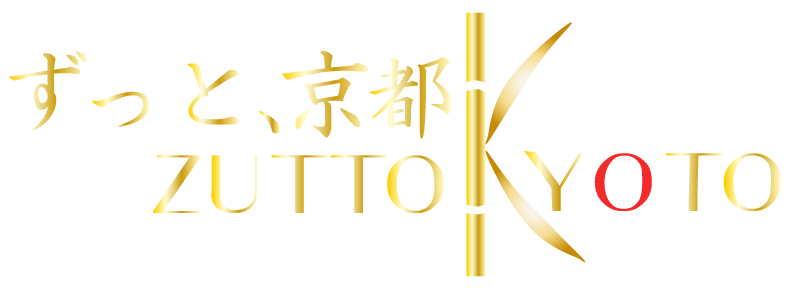Tourist Course
Rakuto Course
This is a recommended course that includes popular spots in Rakuto area.
You will visit the Heian Shrine, Nanzenji Temple, Yasaka Shrine and Kiyomizu Temple.
It is recommended to wear comfortable shoes as there is a lot of walking in this tour.
The first stop is Heian Jingu Shrine.
[By bus from Kyoto Station]
Route 100 and 110 of Rakubus, Route 110 of Rapid Transit, and Route 5 of City Bus (about 30 minutes)
↓
Get off at “Okazaki Park Art Museum Heianjingu-mae” and walk for 5 minutes.
If you go by subway]
Take the Subway Karasuma Line Kyoto Station and get on the train bound for Kokusai Kaikan.
↓
At Karasuma Oike Station on the Subway Karasuma Line, transfer to the Subway Tozai Line bound for Rokujizo.
↓
Subway: Get off at Higashiyama Station on the Tozai Line→approx. 10 minutes on foot
If you’re going on a connection between JR and Keihan Electric Railway
Get off at Tofukuji Station on the JR Nara Line.
↓
Transfer to the Keihan Train bound for Demachiyanagi
↓
Get off at Sanjo Station or Jingu Marutamachi Station on the Keihan Railway→approximately 15 minutes on foot
So let’s head to the Heian Shrine
When you get off the bus, you’ll see a big, impactful torii gate!
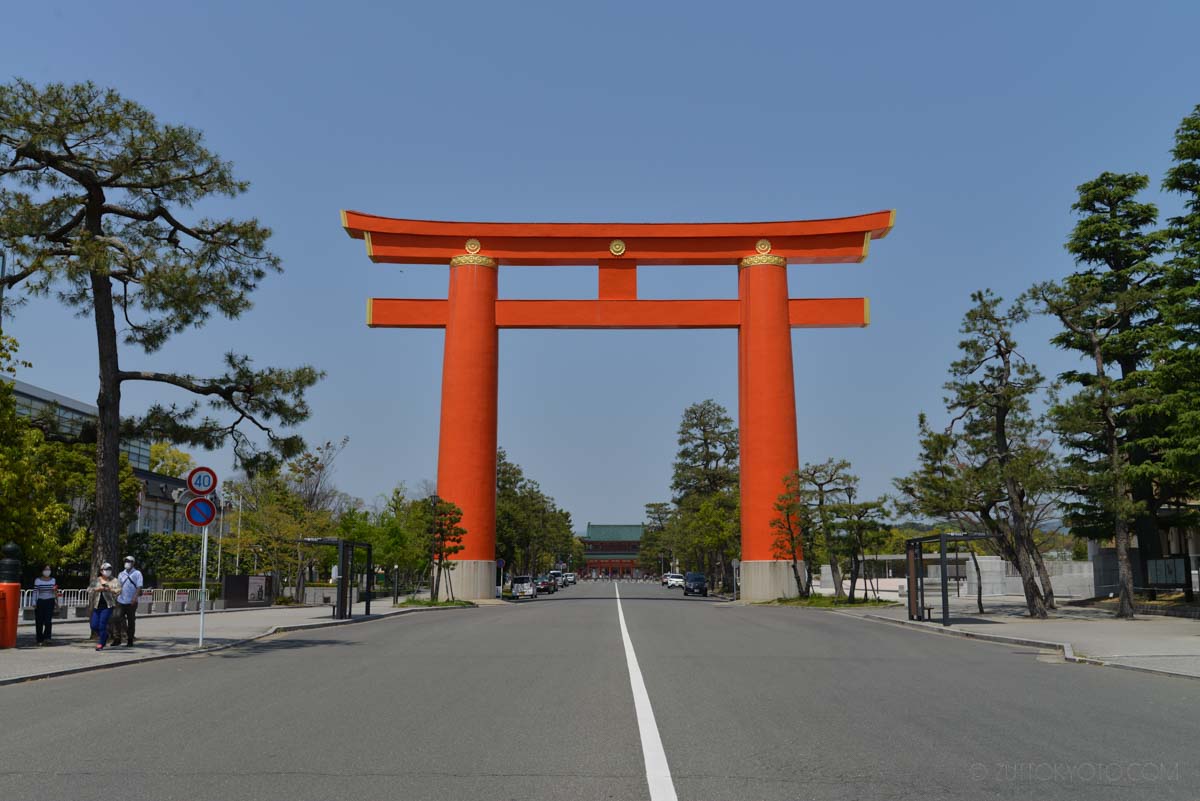
This area is called Okazaki Park, and it’s a place where events are held.
There are also flea markets and other events held here.
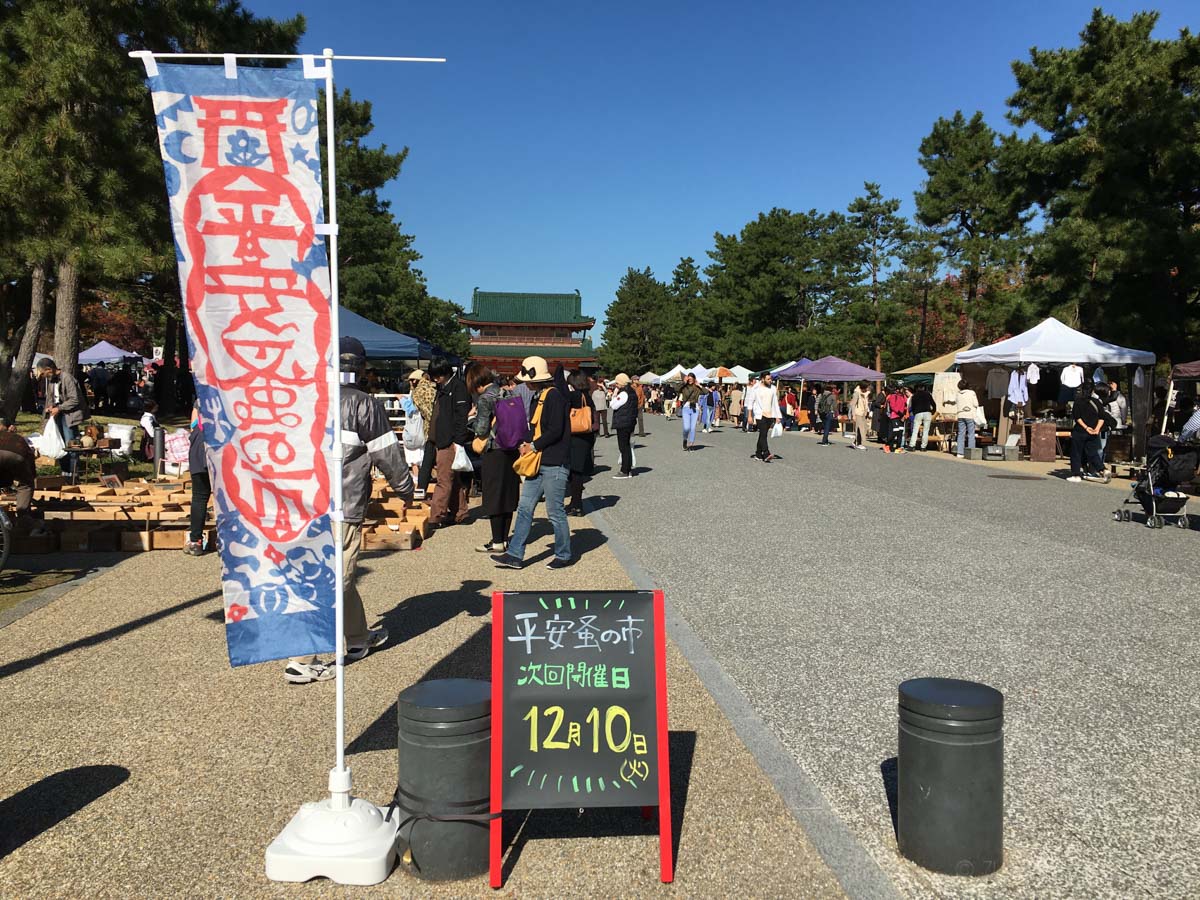
Heian Shrine
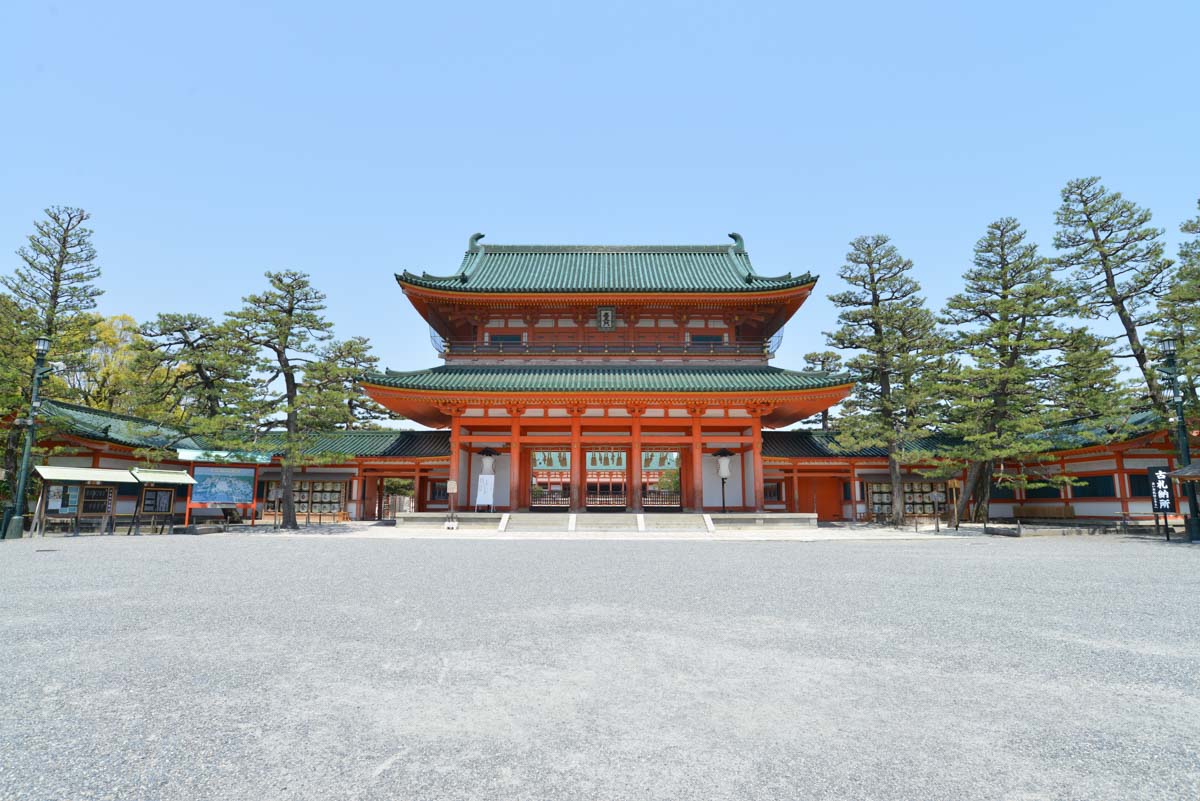
The Heian Shrine was built in 1898 to commemorate the 1,100th anniversary of the transfer of the capital to Heian,
and the shrine was built to honor the 50th Emperor Kanmu,
and the shrine building was a 5/8th scale version of the Asado-in Temple in the Imperial Palace in Heian-kyo.
The grounds of the Heian Shrine are open to visitors free of charge. There is a charge for the Shin-en area.
Shin-en is a garden consisting of four gardens (east, center, west, and south) surrounding the temple,
with a total area of 33,000 square meters (about 10,000 tsubo), which is a national scenic beauty.
You can enjoy the beauty of the four seasons with cherry blossoms in spring and autumn leaves in fall.
The Otenmon Gate (Shinmon Gate), where you can feel the glamour of the court,
and on the left is a strong-looking tiger guarding Heian Shrine. There is a statue of dog(?).
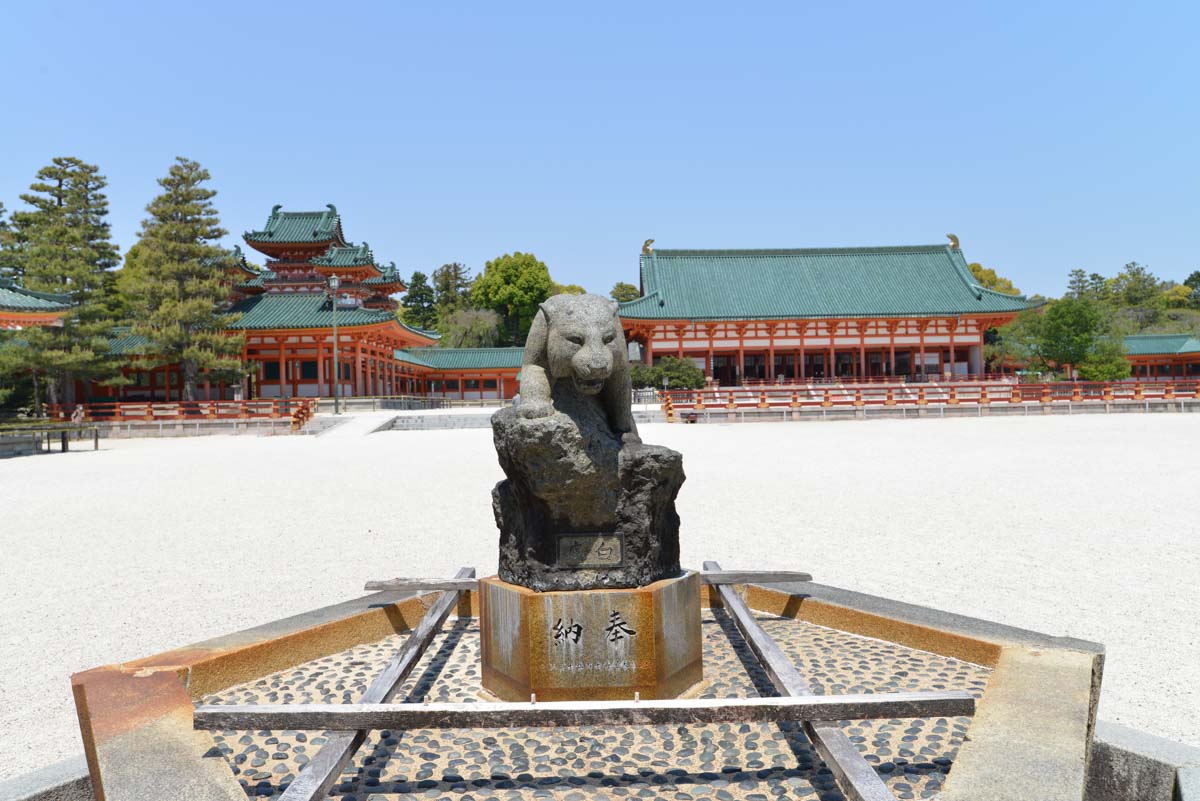
Now let’s go see the Divine Garden!
There is a charge to visit the shrine and the fee is 600 yen for adults and 300 yen for children.
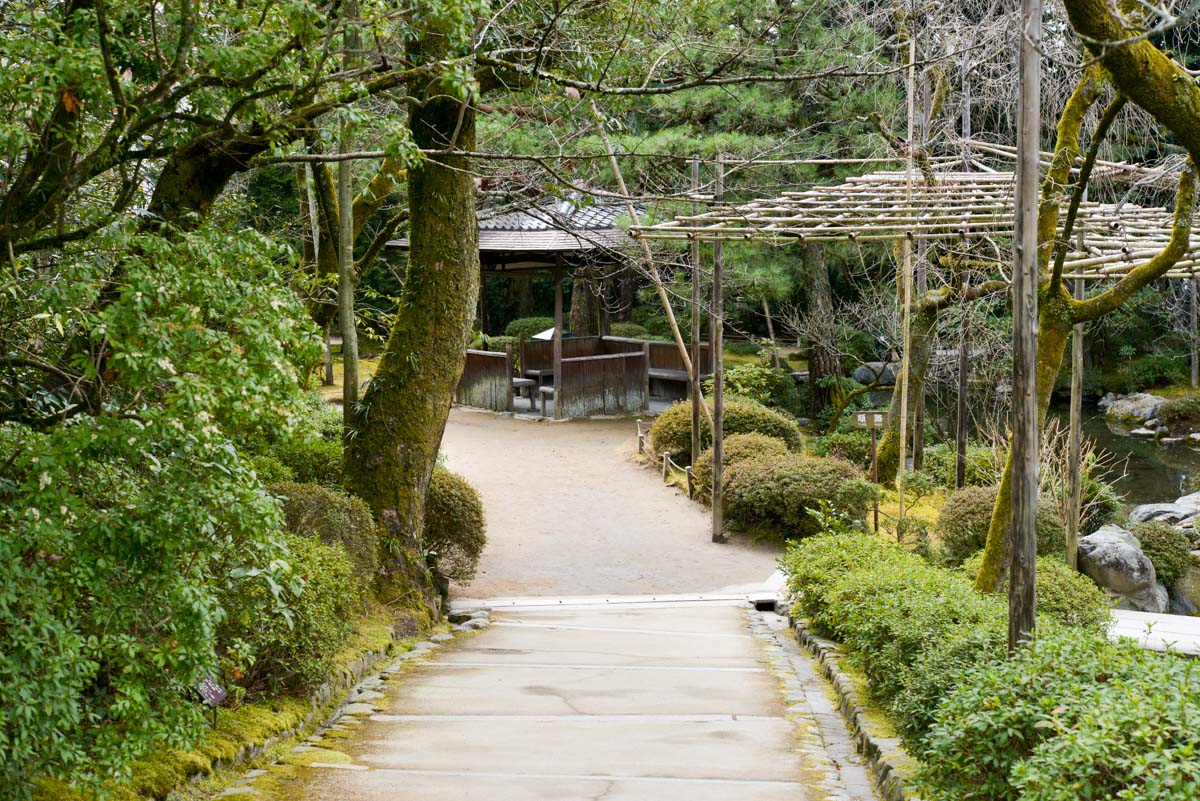
It’s very spacious inside, and there were only a few people in there that day except me.
It is very crowded during the cherry blossom and autumnal leaves season.
By the way, this is what the reception desk looks like during cherry blossom season.
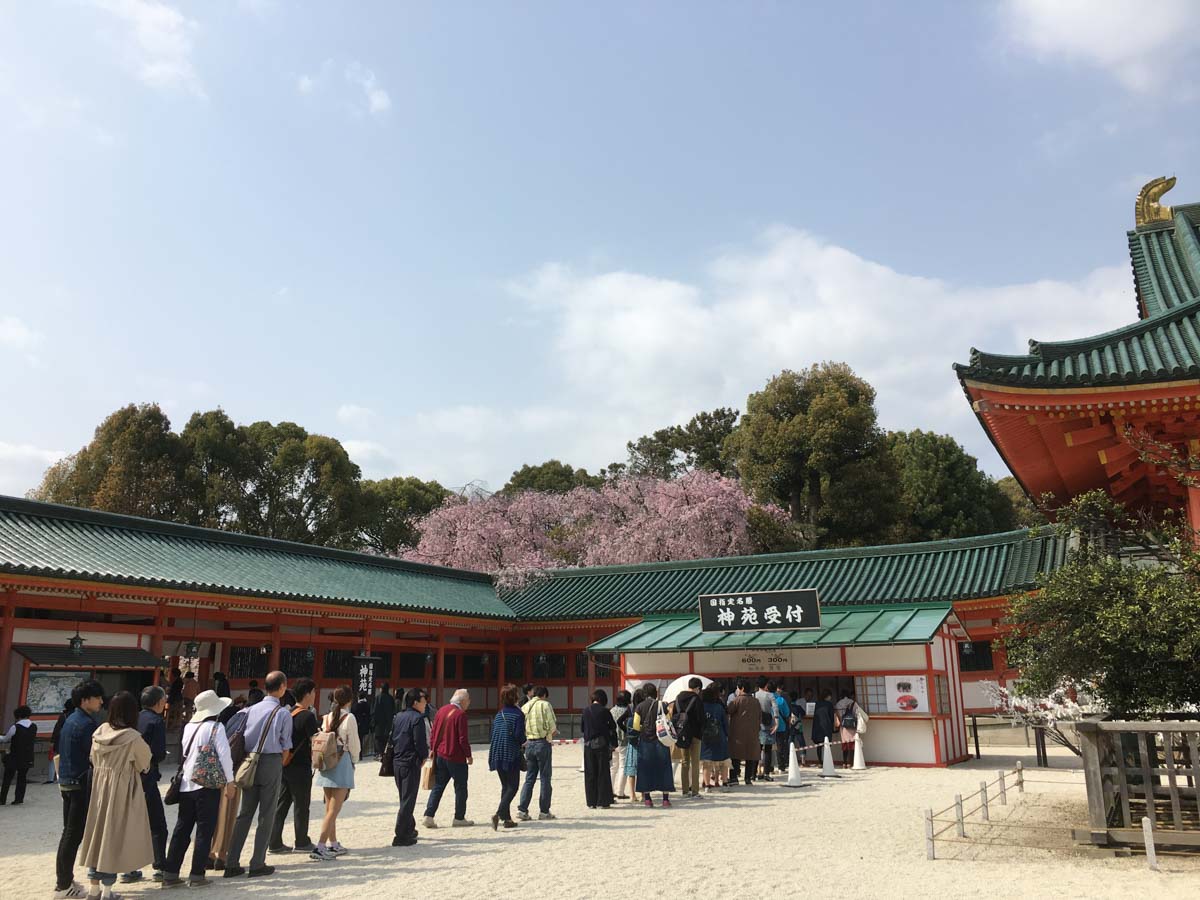
This is Taiheikaku, which was moved from the Kyoto Imperial Palace.
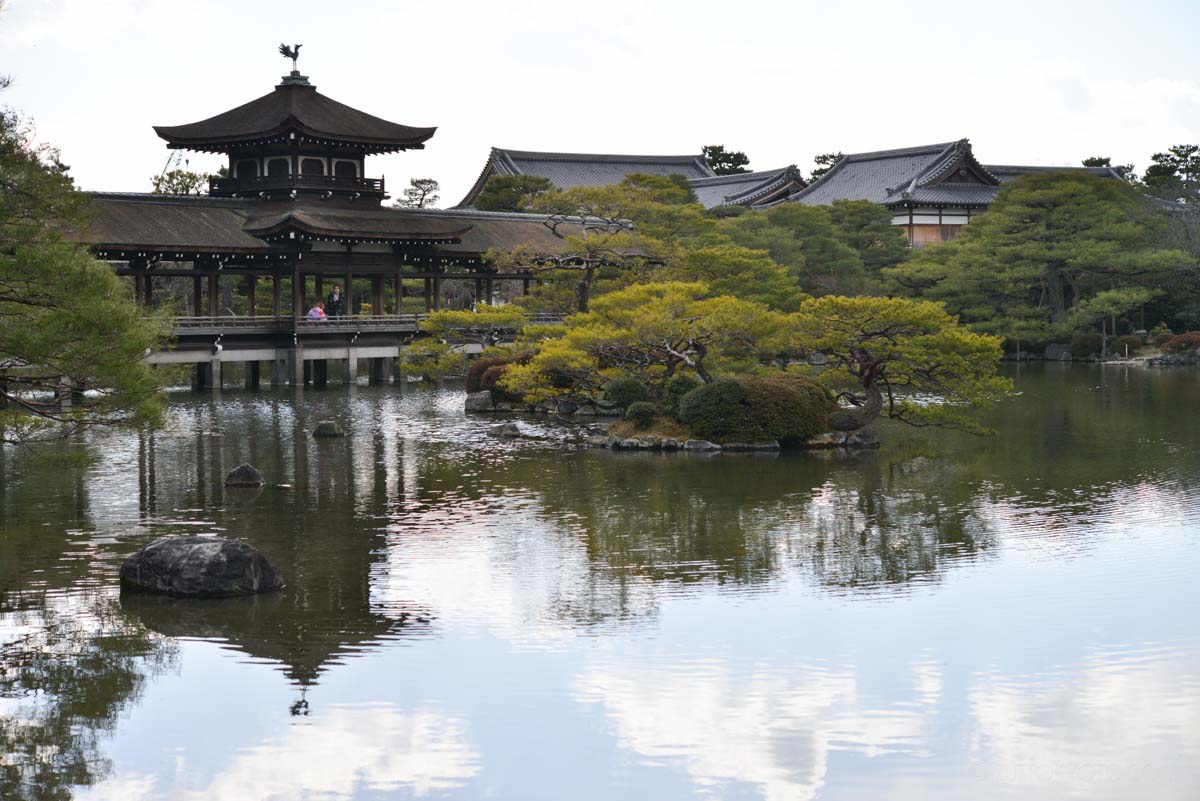
Now, I’m going to enjoy the park slowly… At this time of year, there aren’t many flowers in bloom,
but in early summer, you can see irises, kakitsubata, camellias, azaleas and other seasonal plants!
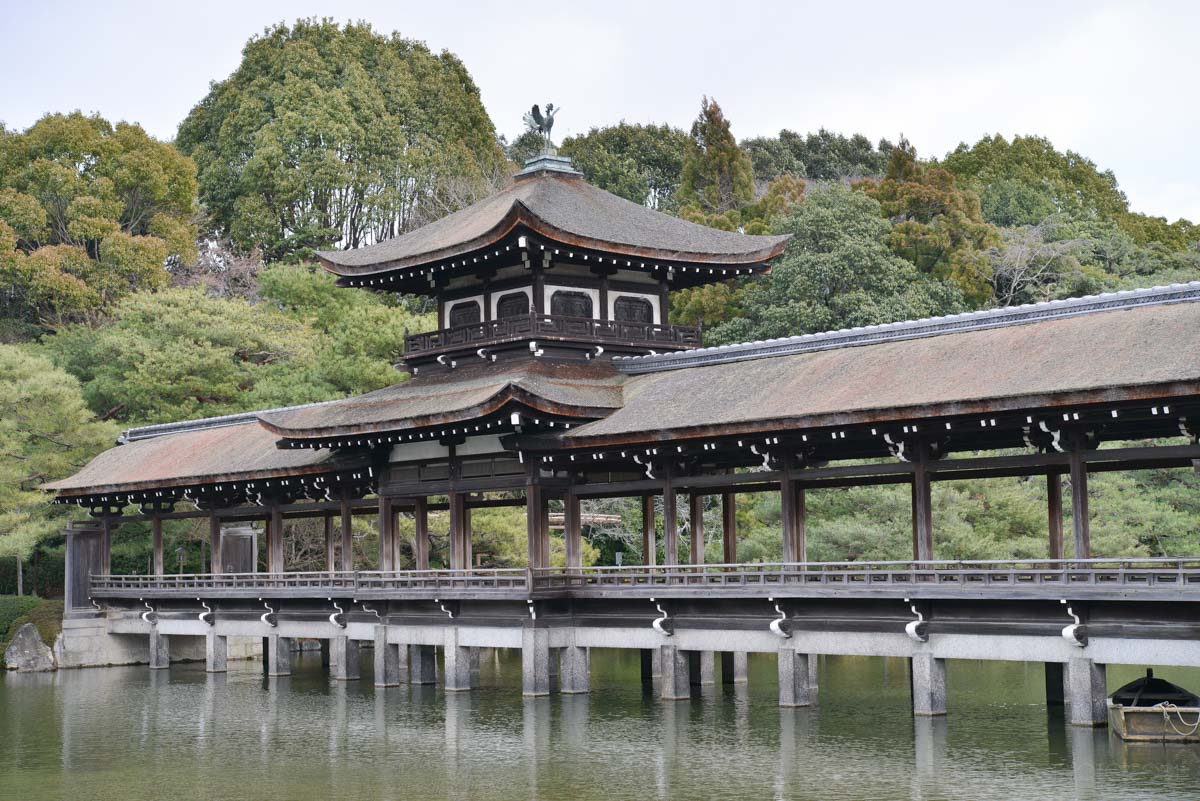
They’re having fun in a nice garden!
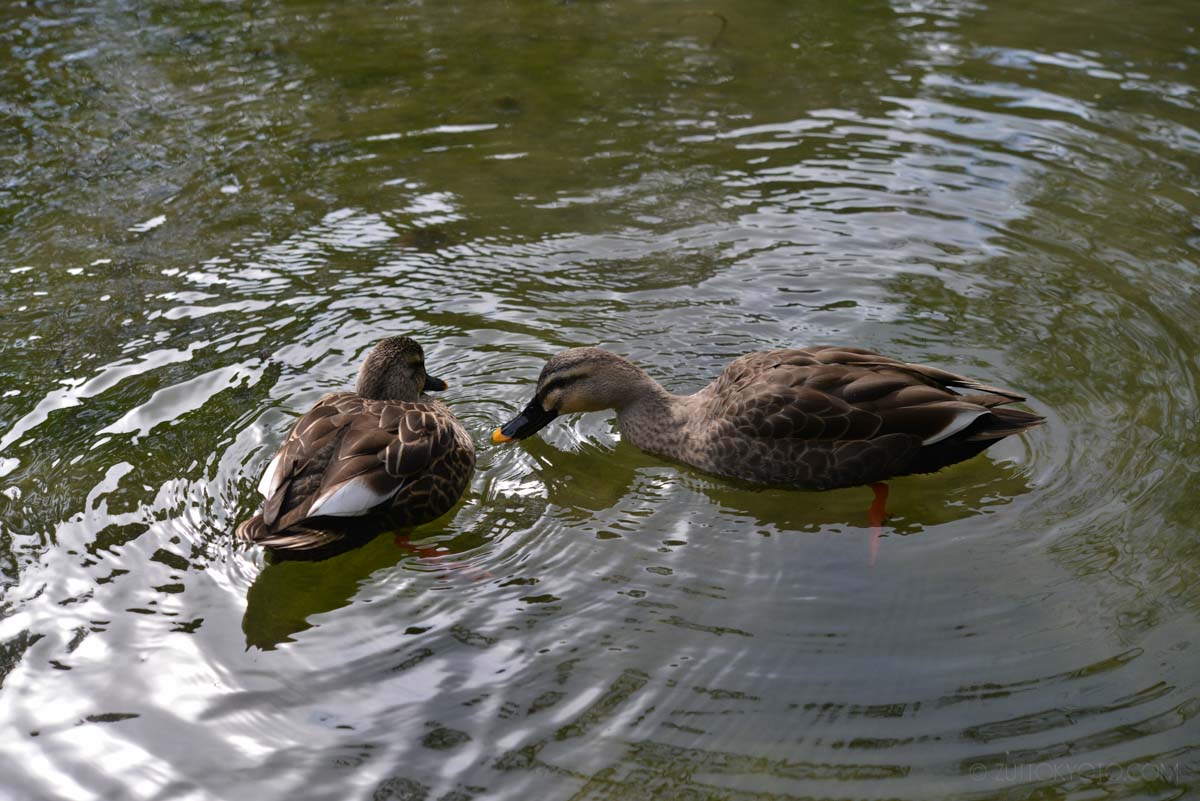
鴨親子も素敵なお庭で楽しそうにしてます(笑)
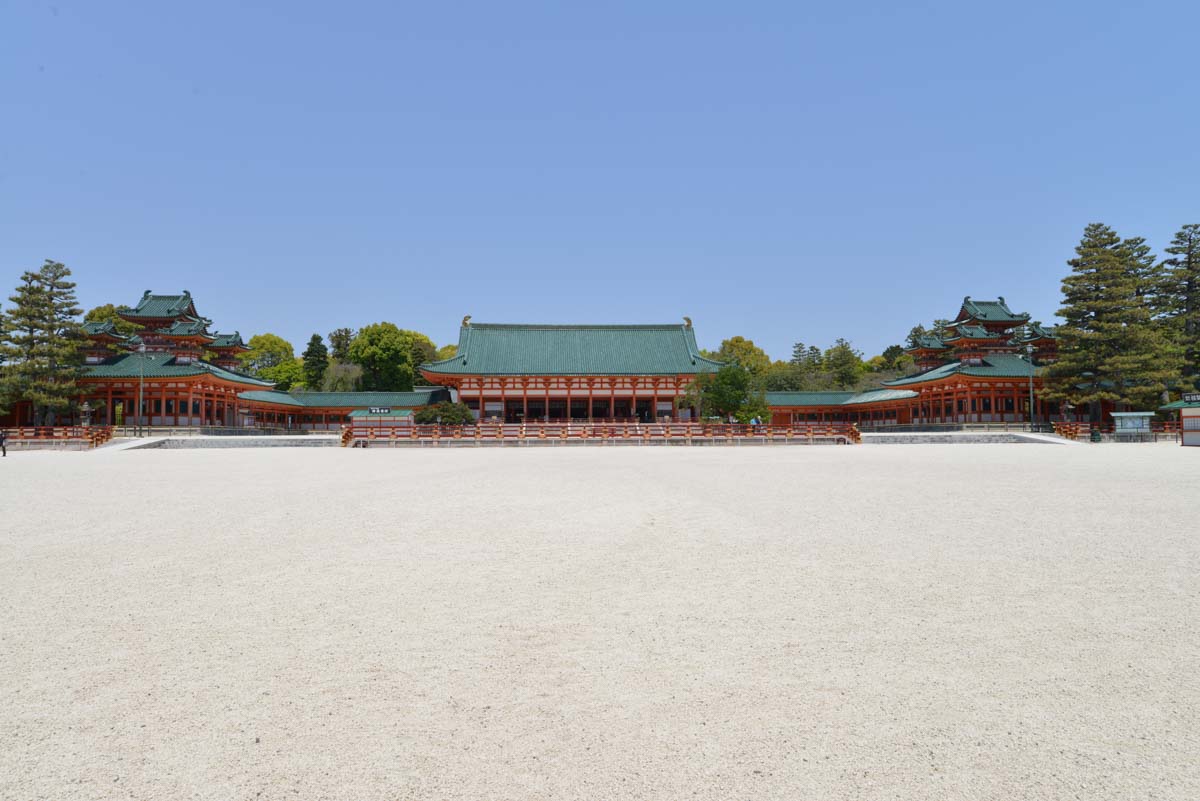
The inside of the shrine garden is large, and it was fun to see all sorts of plants beautifully maintained and planted.
Now, let’s go to Nanzenji Temple next, which is a 15-20 minute walk from the Heian Shrine.
If you want to have a cup of tea before that, there is a Starbucks at Tsutaya in Okazaki, Kyoto.
You can enjoy a cup of coffee while reading a book.
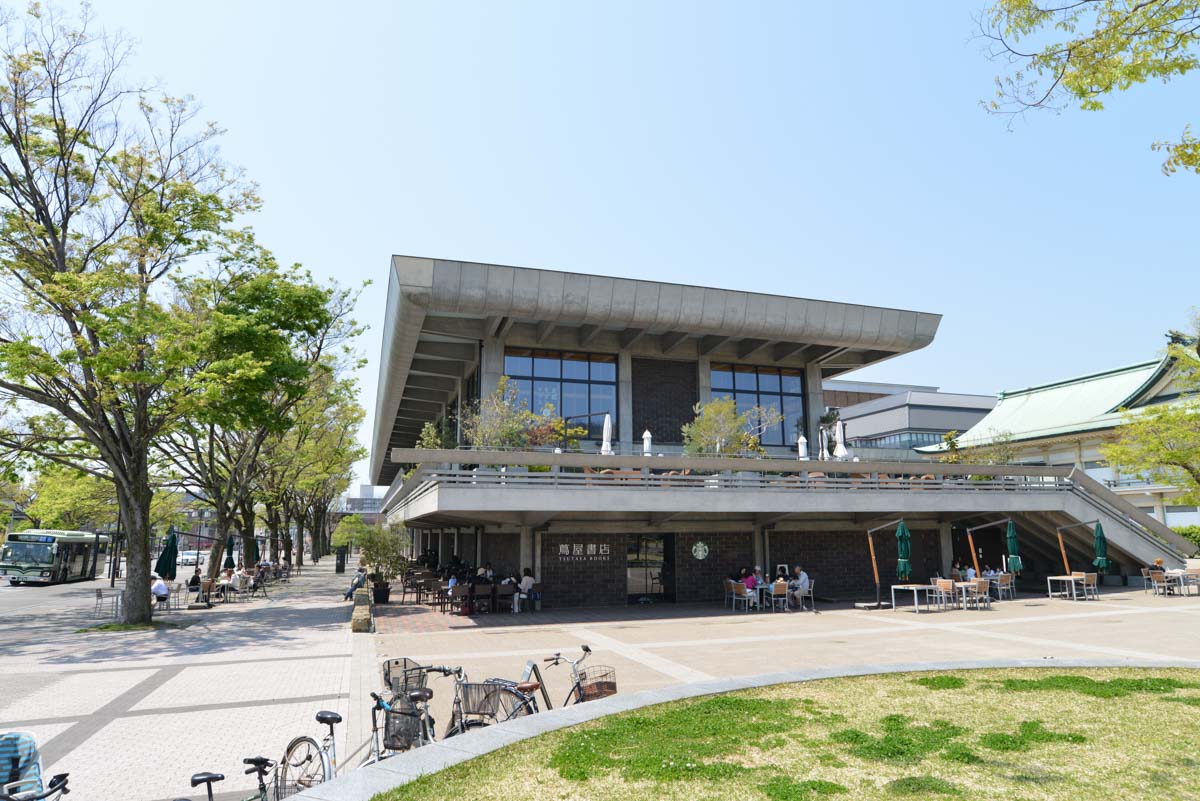
It can get up to 30 degrees Celsius in Kyoto even in early summer,
so if you are going to visit the city, don’t forget to hydrate yourself to prevent heat stroke.
On the way to Nanzenji, there is a famous cherry blossom spot, Keage Incline.
Keage Incline
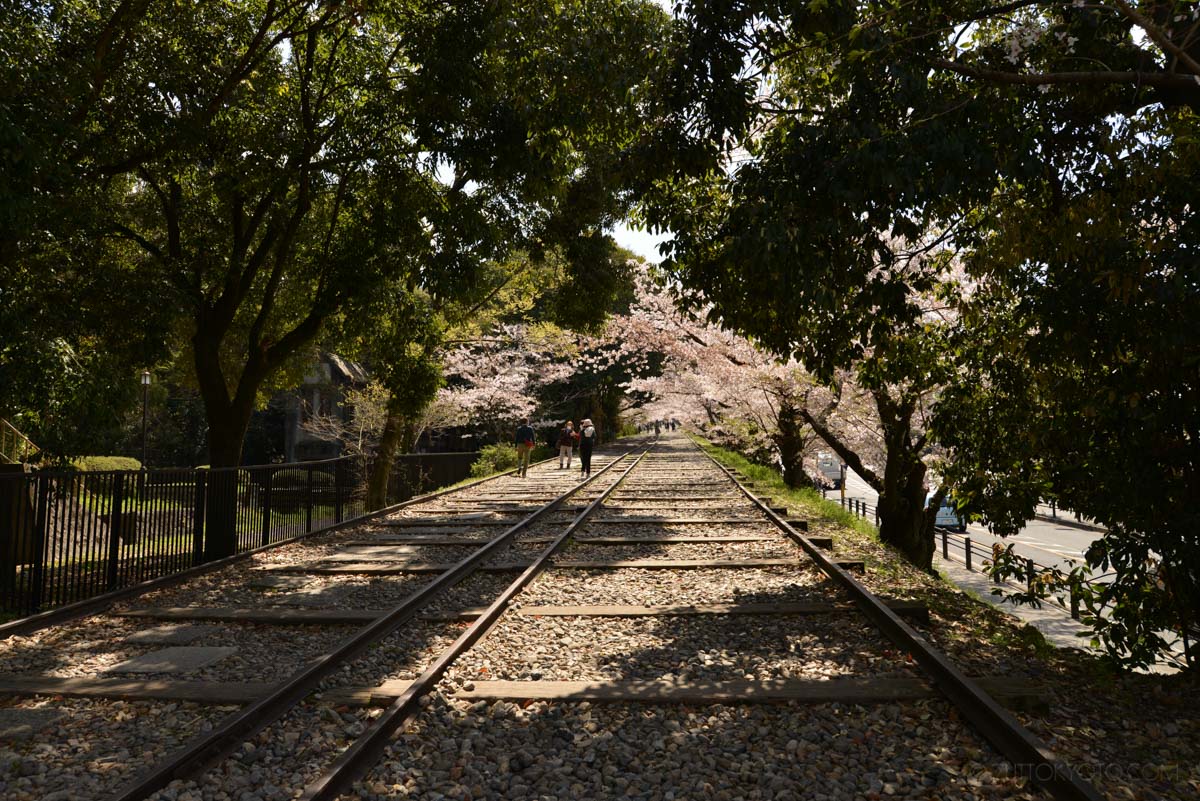
In 1890, the construction of Lake Biwa was completed,
and one of its purposes was to transport ships between Kyoto and Otsu in Shiga Prefecture,
but since ships could not operate at the site of the big drop, they used an incline
that was mounted on a dolly and was in use until 1948.
It’s really beautiful during the cherry blossom season, and many people visit this place.
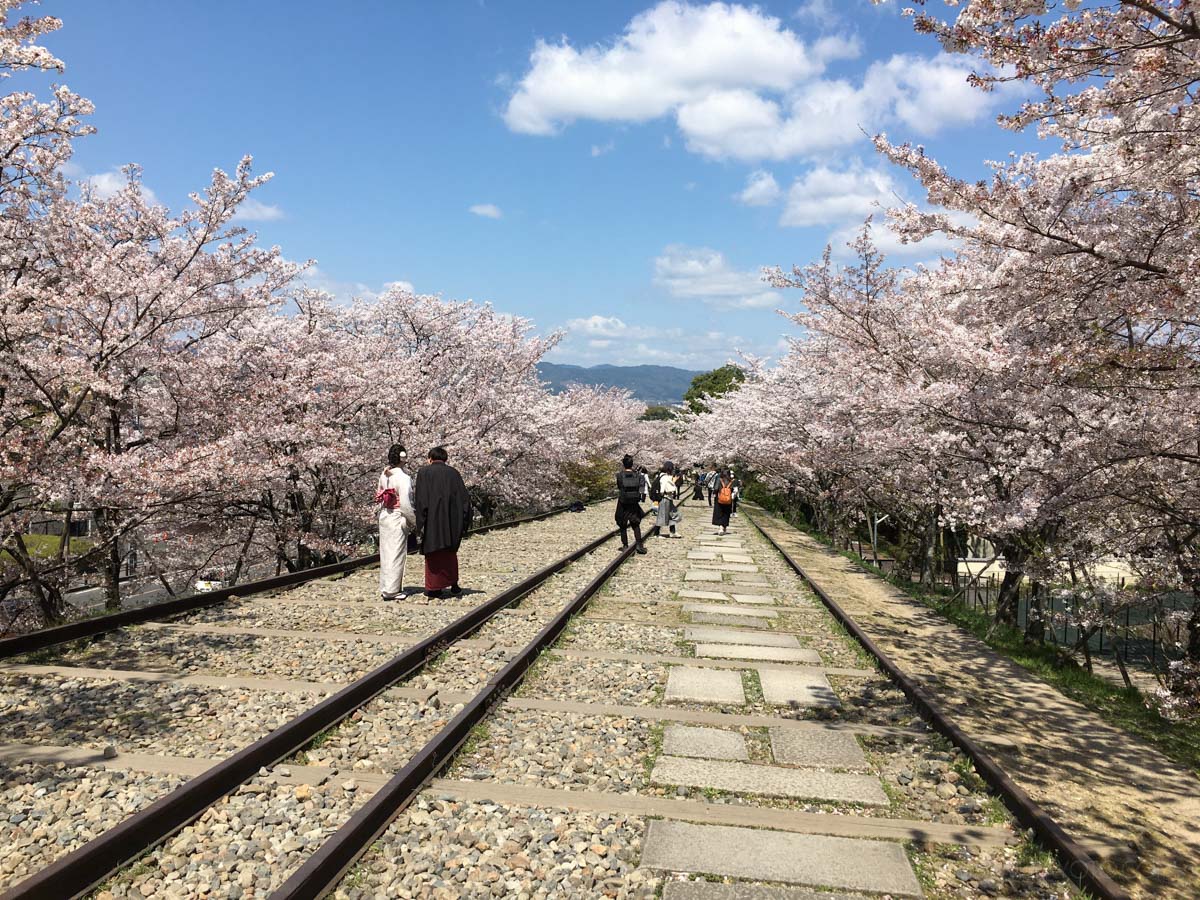
I’ve arrived at Nanzenji!
Nanzenji Temple
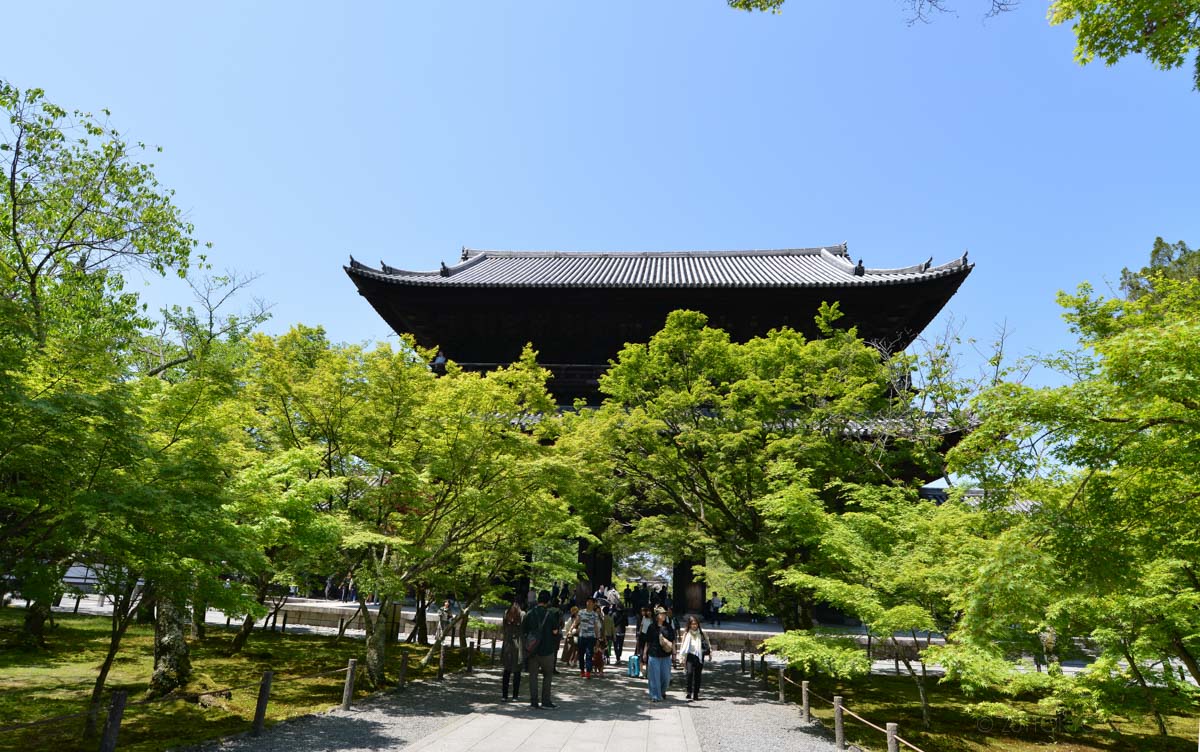
Nanzenji Temple was founded about 700 years ago by the Emperor Kameyama,
who built a detached palace, and in 1291 the Emperor became the Emperor of Japan,
and the detached palace was renamed Zenrin Zenji Temple.
The temple is considered to be one of the most prestigious Zen temples in Japan,
ranking above the five mountains of Kyoto and Kamakura.
It is also famous for the legend of Ishikawa Goemon. Nanzenji Temple is also very beautiful during
the season of cherry blossoms and autumn leaves.
This aqueduct was built to take water from Lake Biwa and carry it to Kyoto, and it is still in use today.
This aqueduct was completed in 1890 and was supervised by a young man in charge of construction at that time who was 21 years old!
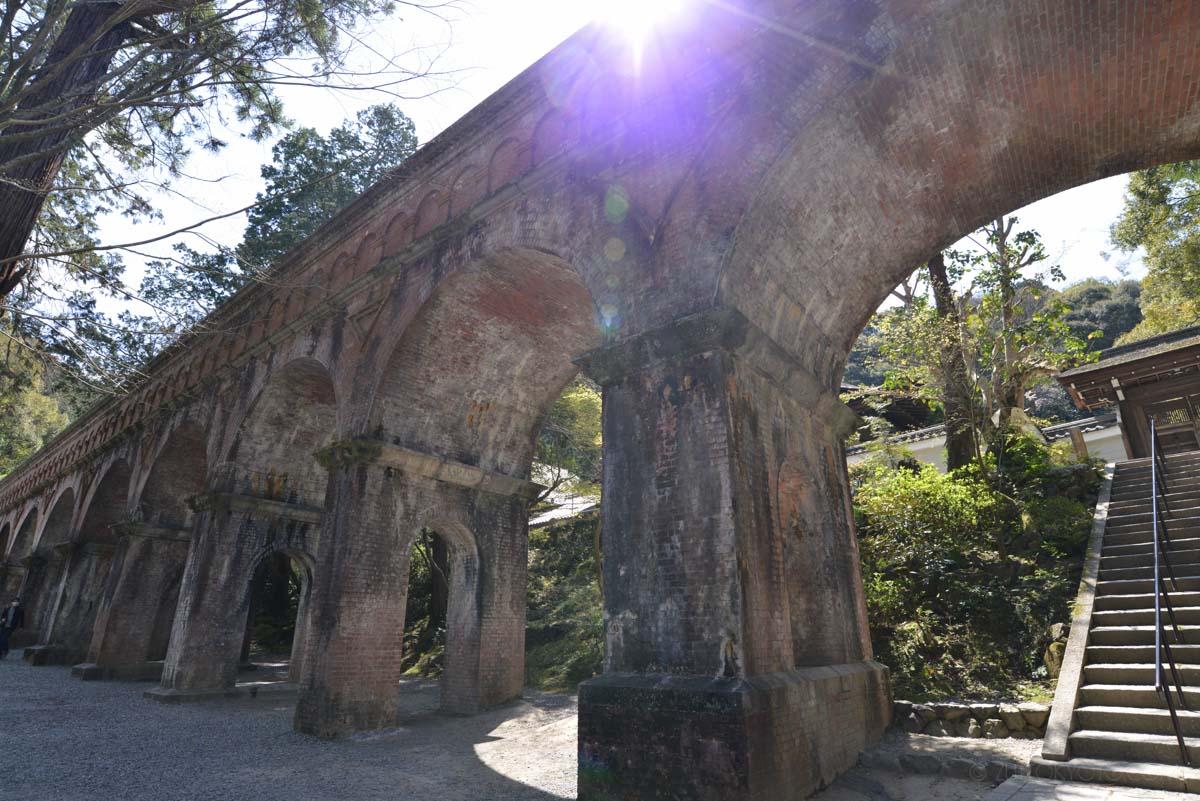
The artistic waterway pavilion was very popular with tourists and it was very crowded with people taking pictures.
The precincts of Nanzenji and the Waterway Pavilion are free to visit.
There is a charge for the Hojo garden and Sanmon Gate in Nanzenji.
Now let’s go to Yasaka Shrine! It takes about 30 minutes to get to Yasaka Shrine on foot.
If you have time, we recommend that you visit Chion-in if you go through the Maruyama Park via Seiren-in and Chion-in,
etc. Chion-in Temple is also famous for the largest three gates in Japan and the temple’s bell at night.
The view during the cherry blossom season is wonderful.
Chion-in Temple
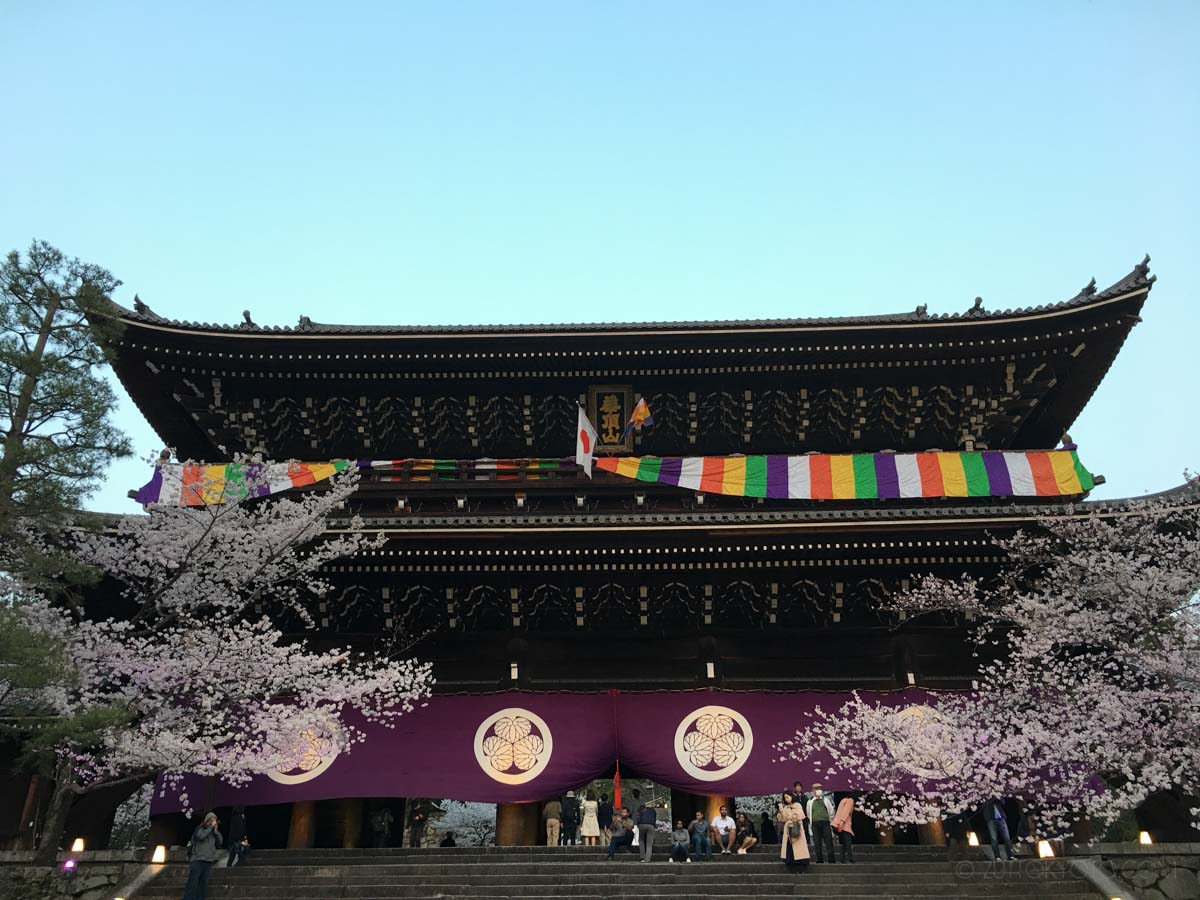
After passing Chion-in, you will find Yasaka Shrine. From Yasaka Shrine,
you will be connected to Maruyama Park, famous for its weeping cherry blossoms.
Yasaka Shrine
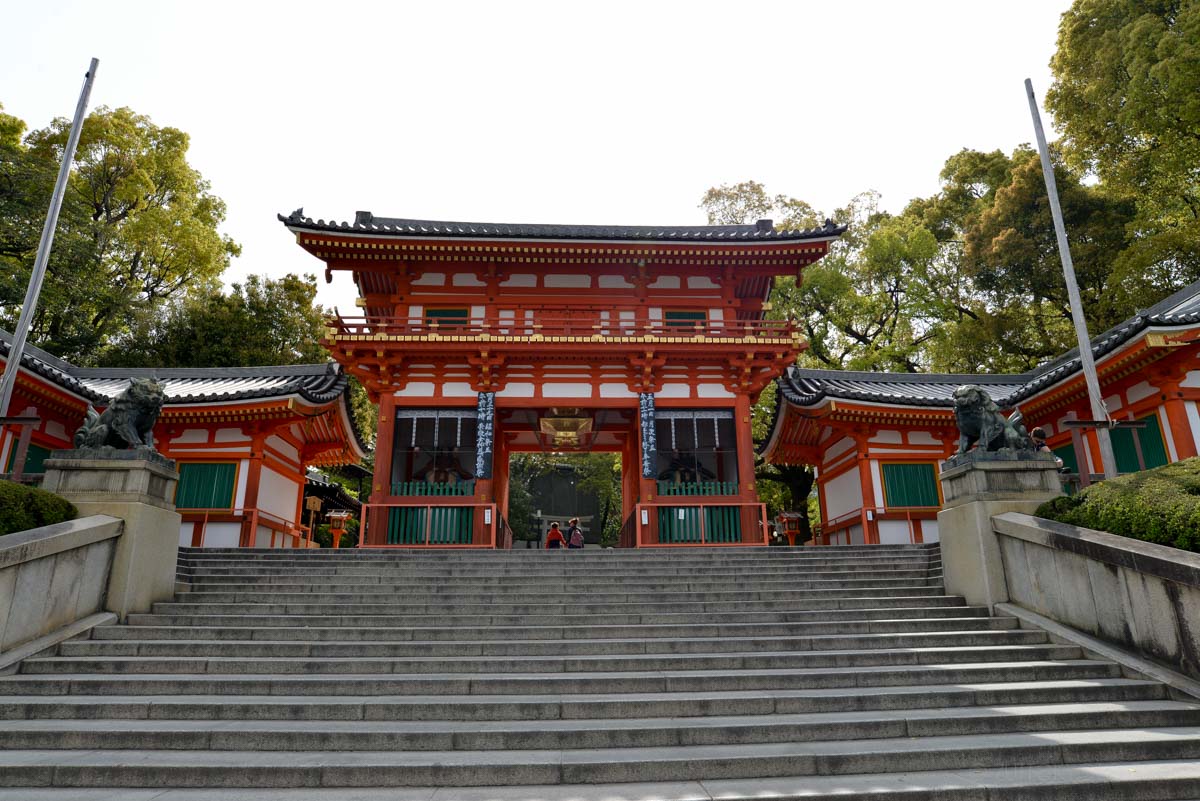
Yasaka Shrine is also known as Gion-san, and the Gion Festival, the three festivals of Kyoto,
is a major festival of Yasaka Shrine.
This gate is the Seiroumon gate. If you want to take a photo of Yasaka Shrine’ Gate,
please go west to Shijo Street and take a picture of the shrine.
Fortune telling fortunes and love fortunes are especially popular among girls and women!
It’s a fortune slip to buy by telling the number of the stick which came out from this wooden box to the receptionist.
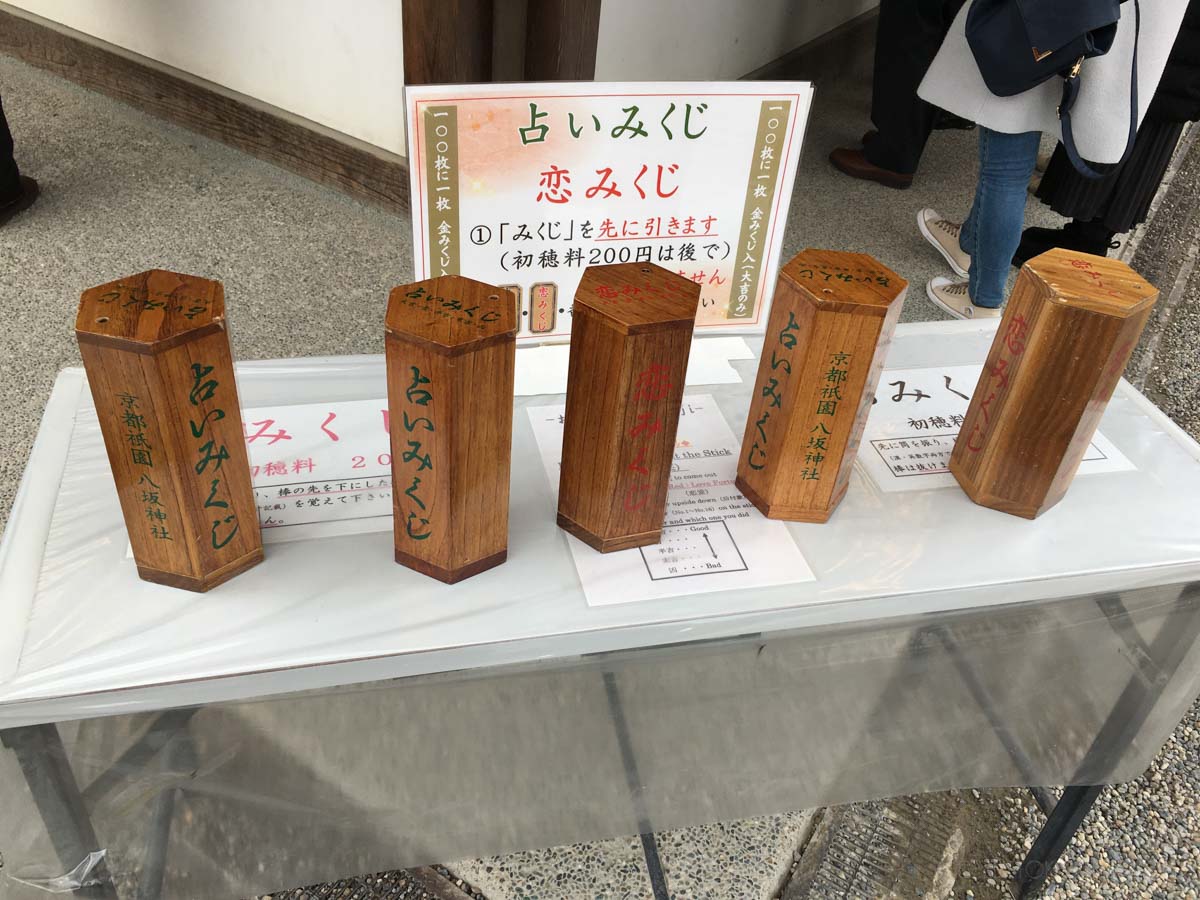
Next, we’ll head to Kiyomizu-dera Temple. In the distance is Hokanji Temple, commonly known as Yasaka-no-To(Yasaka Tower).
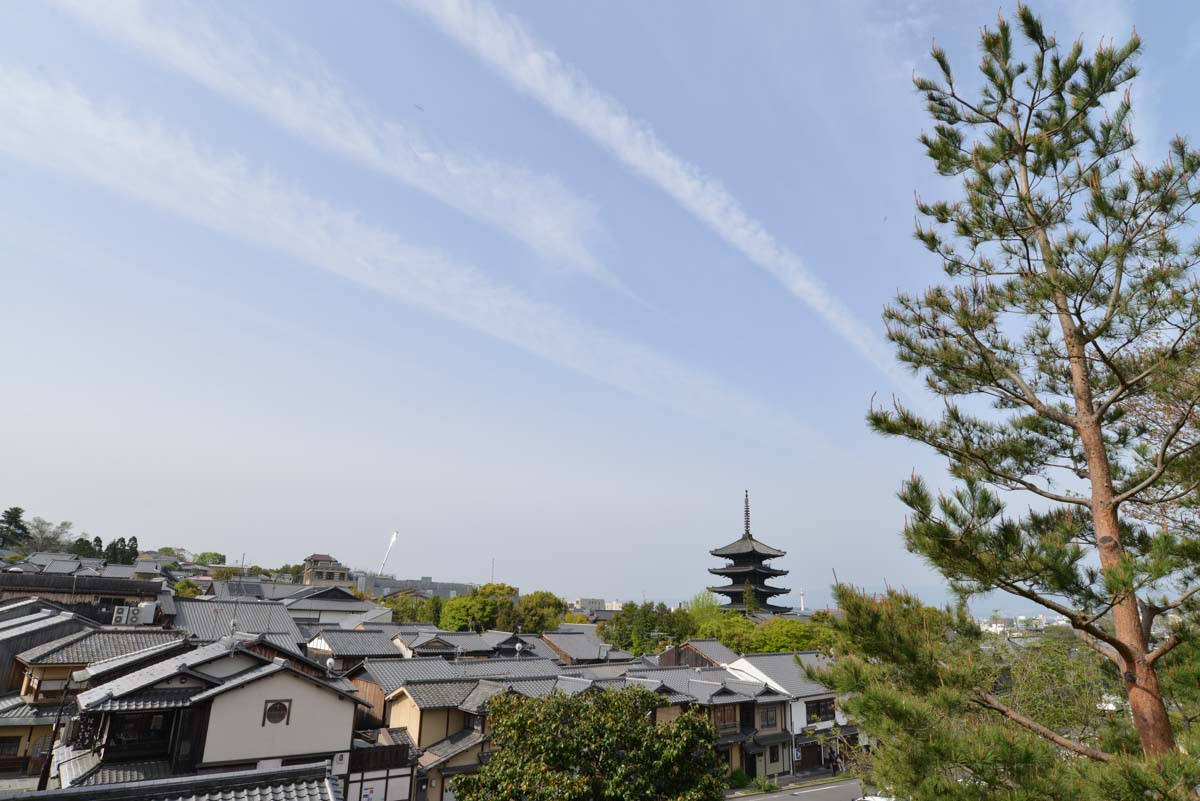
Walk along the road of Tane, the wife of Toyotomi Hideyoshi.
The origin of Nene no Michi is that she built Kodai-ji Temple after her husband Hideyoshi passed away and
spent the rest of her life in this place. In the picture below, Nene no Michi (Kodai-ji Temple Kitamon-dori Street) is a beautiful stone-paved street,
and this area is a preservation district of traditional buildings of Sanneizaka.
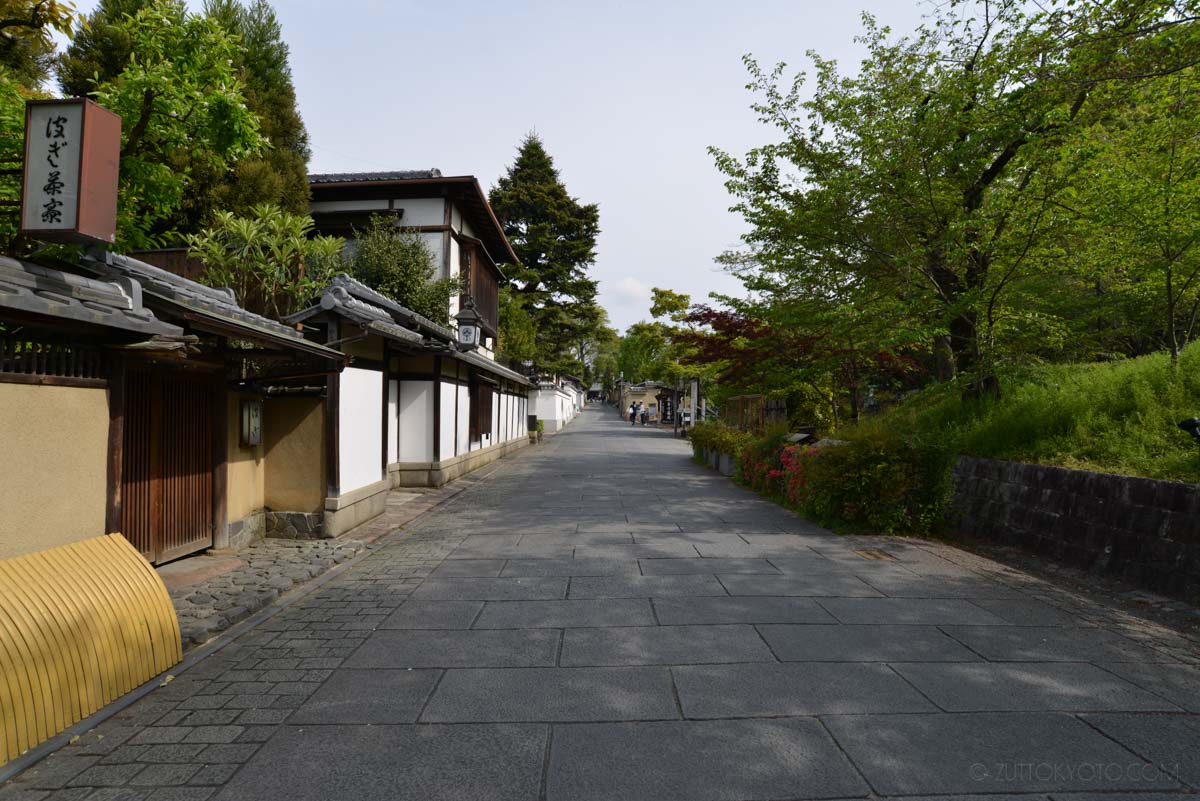
Kodaiji Temple is also famous for its cherry blossoms. In front of Kodaiji Temple, there is Kodaiji Tenmangu Shrine.
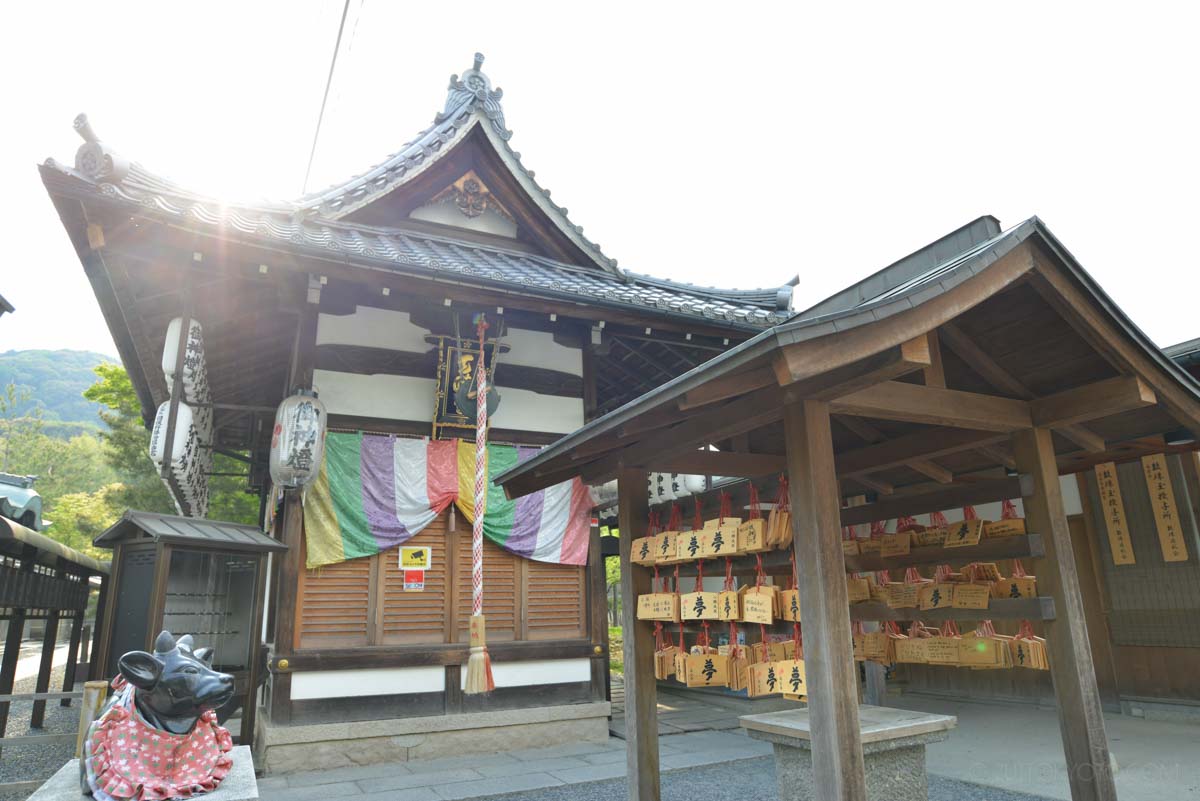
There is a statue of Toyotomi Hideyoshi and his wife, Kitamazokoro Nene.
It is said to bring good luck to married couples.
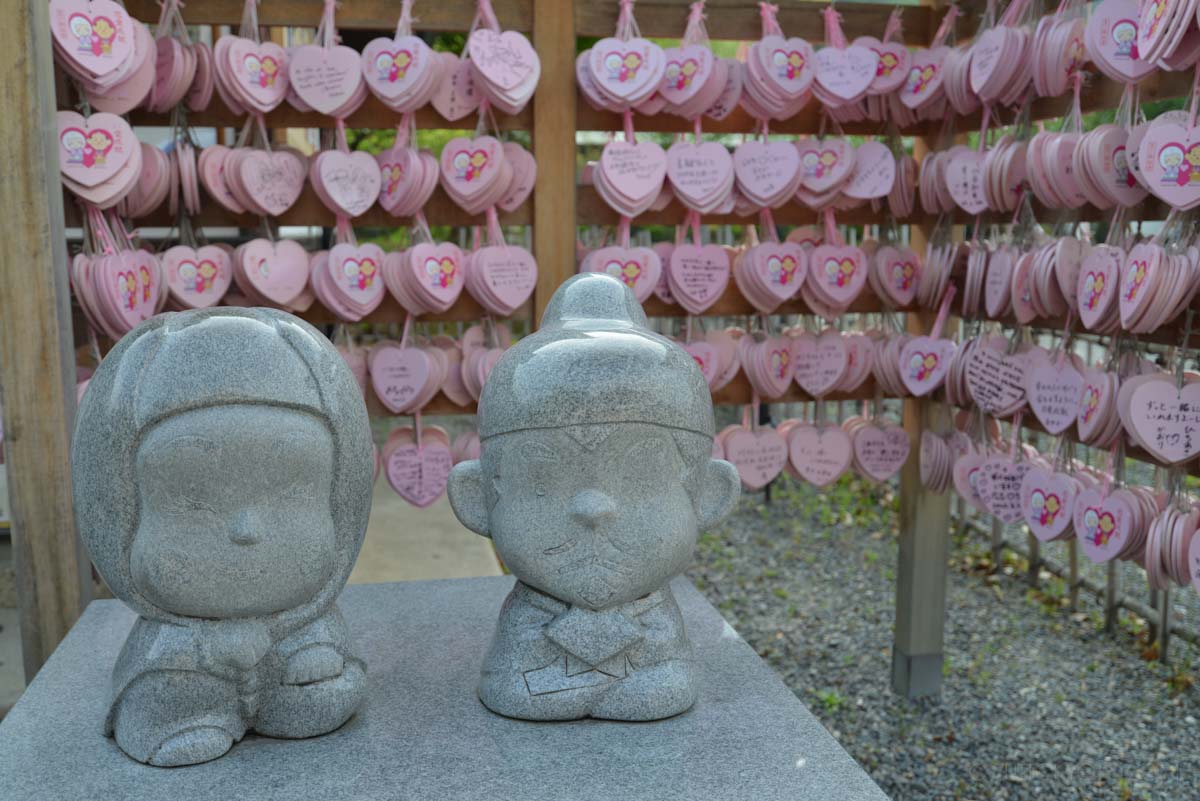
Just ahead is Hokanji Temple, as shown on the top page of this site. It is commonly known as Yasaka-no-To (Yasaka Pagoda).
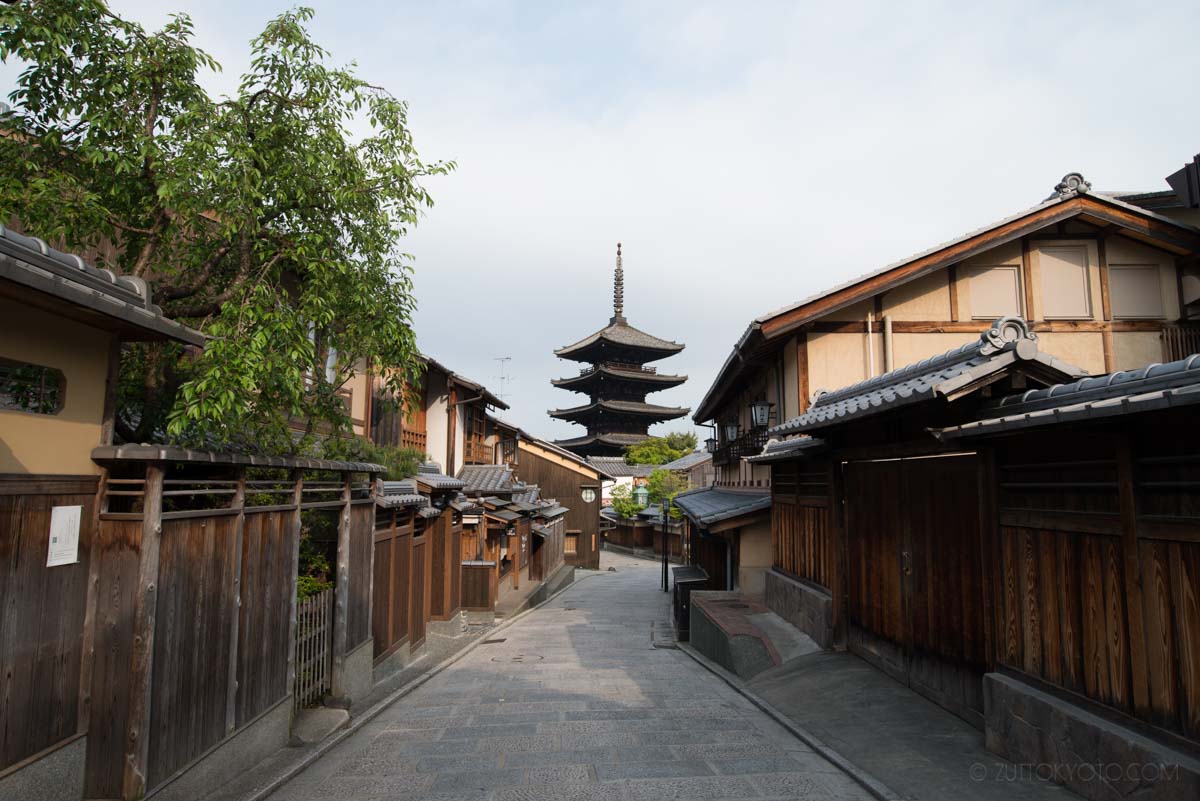
If you’re looking for a photo shoot, I’d recommend early morning when there are fewer people around!
It’s a popular photo spot for tourists from all over the world.
On the way to Kiyomizudera Temple, there are two slopes on the way to Kiyomizudera,
Ninenzaka and Sannenzaka, which are lined with many long-established shops,
shops specializing in Kyoto-style goods and sweets, and souvenir shops.
There are some shops where you can have a bite to eat and walk around.
Kiyomizudera Temple
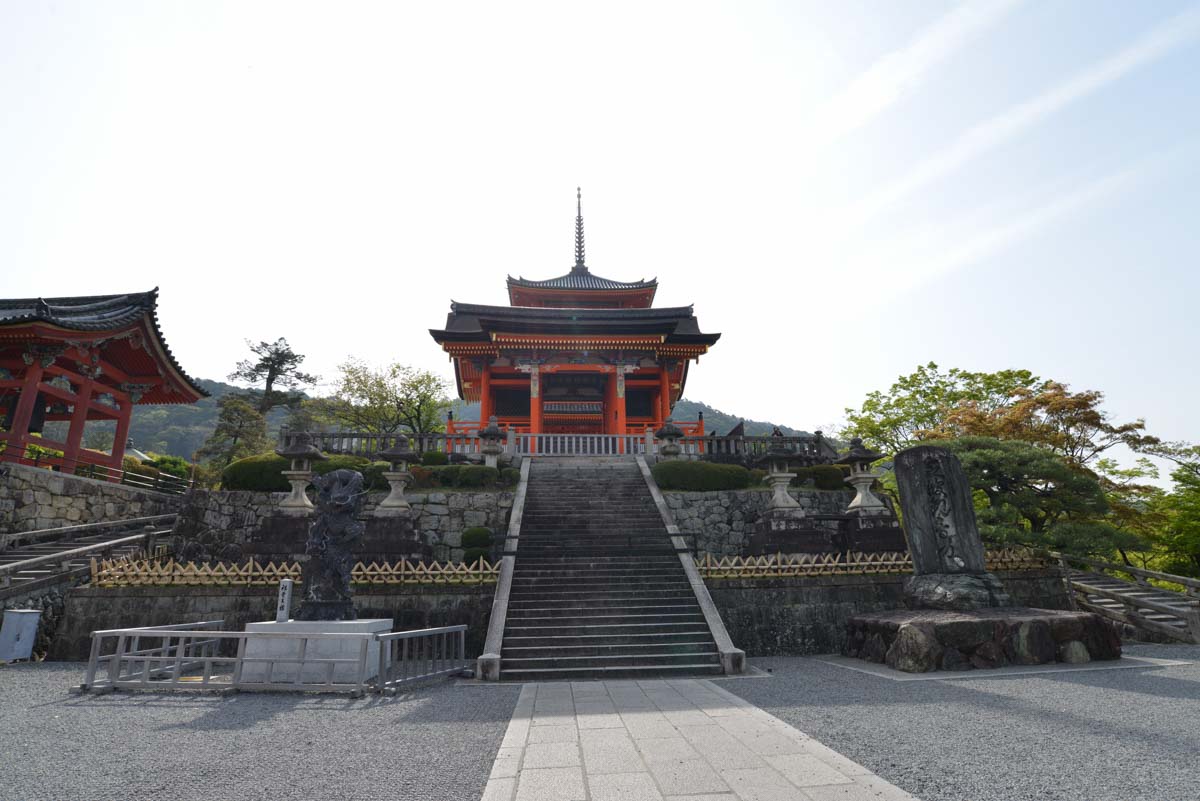
This is the west gate. It looks as if a halo is shining on it, which is very mysterious.
It is said that the origin of Kiyomizu-dera Temple dates back to 780 A.D., before the Heian-kyo Capital relocation,
when Sakagami Tamuramaro met Kenshin (later renamed Enchin), who was training to hunt deer in the area.
The main hall has been burned down many times, but the present hall was rebuilt in 1633 with donations from Tokugawa Ieyasu.
Kiyomizu-dera Temple, famous for the stage of Kiyomizu, is a popular spot for tourists from all over the world to visit.
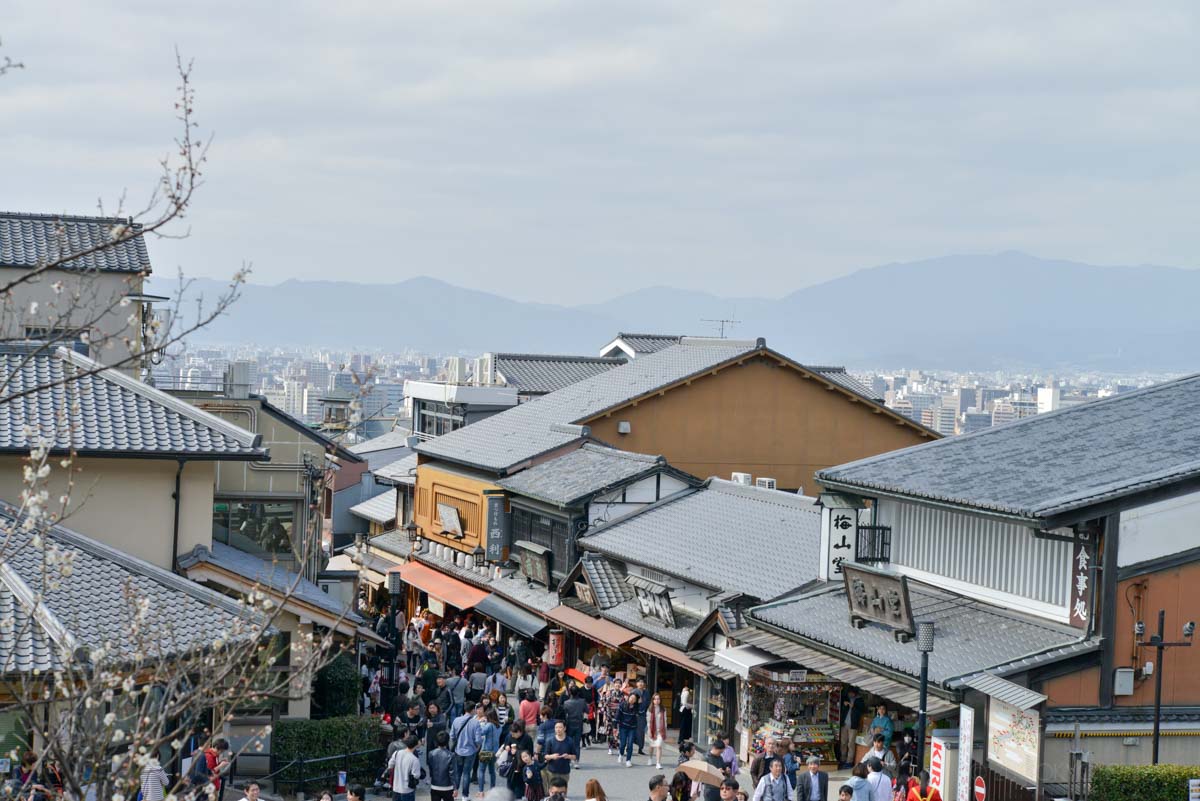
In recent years, a major renovation and repair work began in 2008, with a total construction cost of approximately 4 billion yen,
and the main building was covered with a bare roof of Japanese cypress bark, so it was not visible.
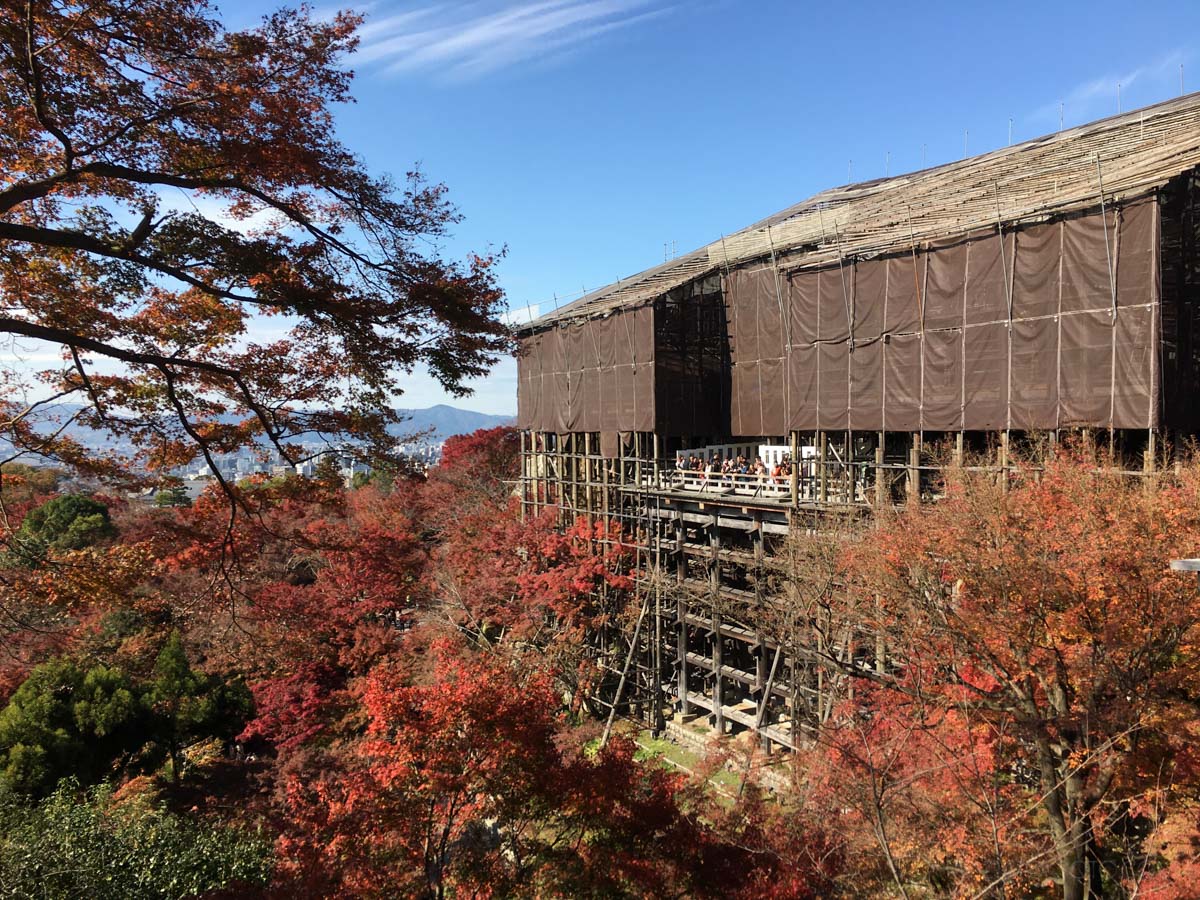
But this year, we went to see the whole thing when the cypress bark roof replacement is finished in late February 2020!
Admission: 400 yen for adults, 400 yen for high school students, 200 yen for junior high school students,
and 200 yen for elementary school students.
The place on the right of the picture below is the stage of Kiyomizu,
which is famous for the proverb “Jumping down from the stage of Kiyomizu”.
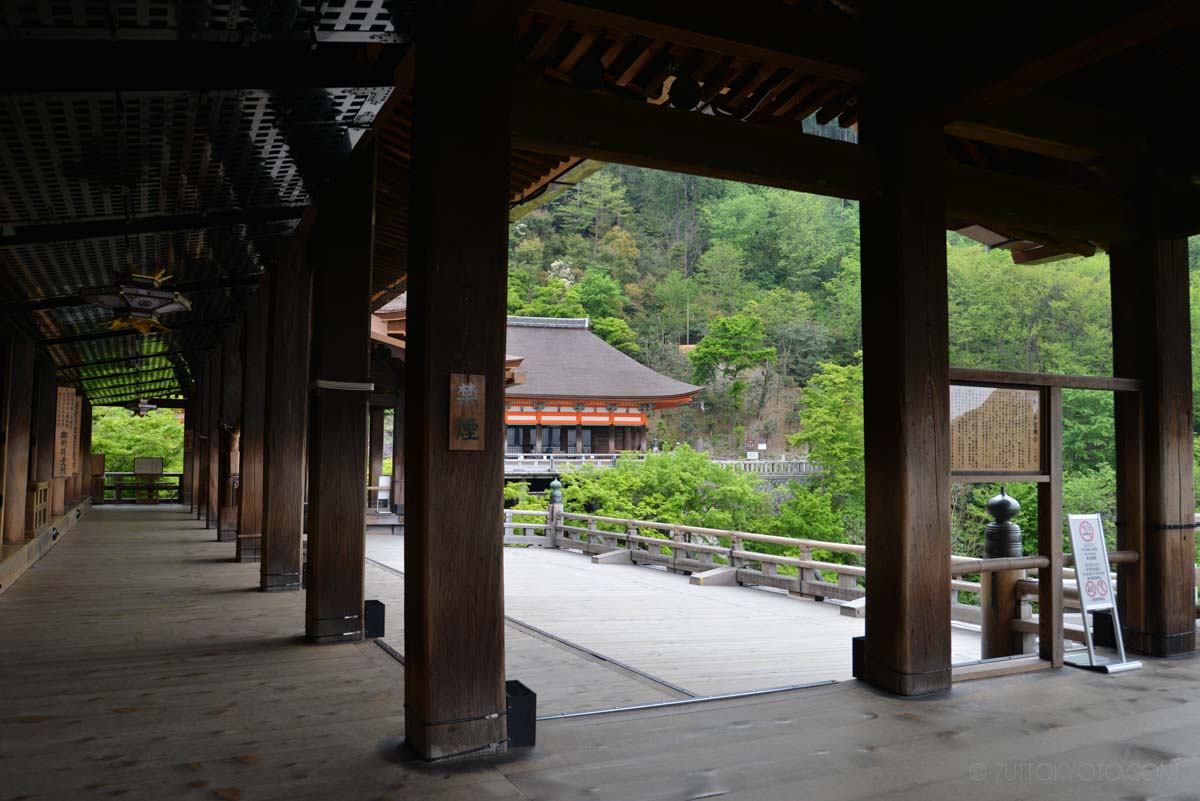
Let’s get out on stage! By the way, the origin of jumping off the stage of Kiyomizu-dera Temple is a folk belief that started in the Edo period,
which says, “If you sacrifice your life to the Goddess of Mercy at Kiyomizu-dera Temple and survive by jumping off the stage of Kiyomizu-dera,
your wish will come true, and even if you die, you will attain Buddhahood and return to the Goddess of Mercy.
It is said that there was no end to the number of people jumping off the stage until the prohibition of jumping off was issued in 1872.
By the way, the survival rate is said to be about 85%. It’s a little scary to know that there were really people who jumped off.
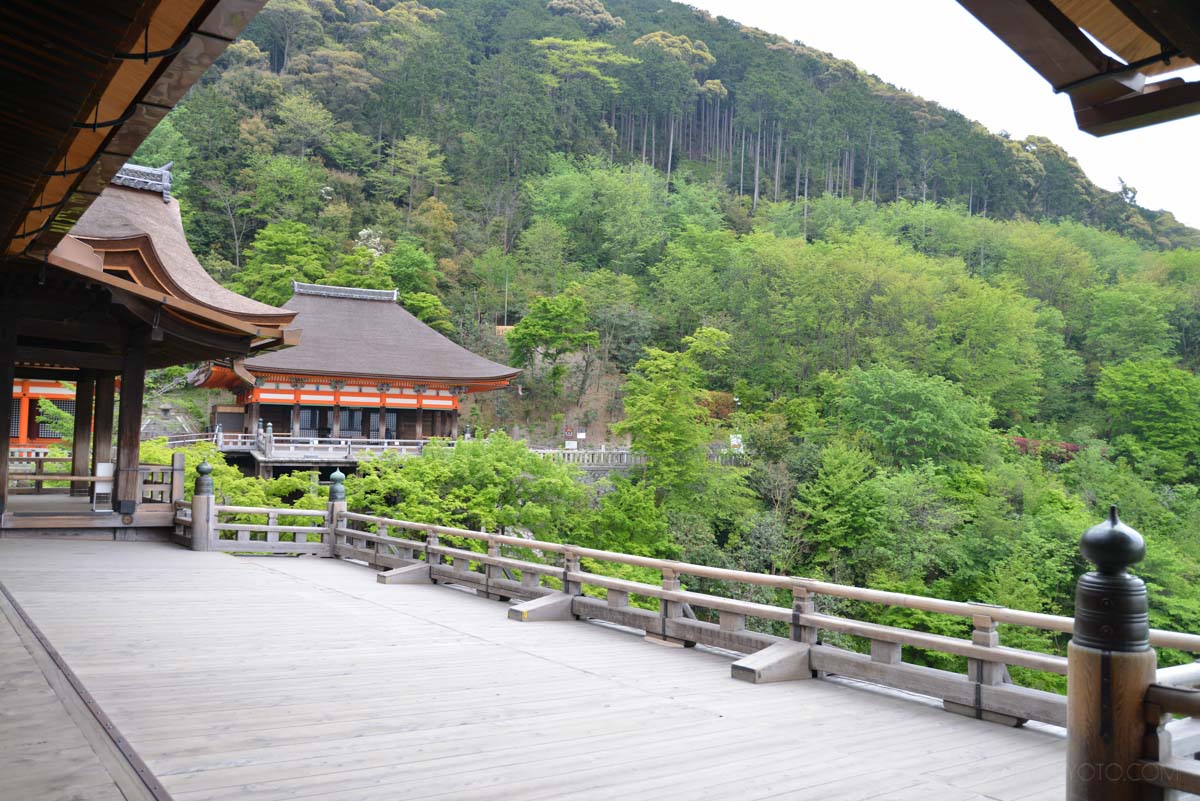
The view from the Kiyomizu stage. The three-storied pagoda in the distance is the Koyan-no-To.
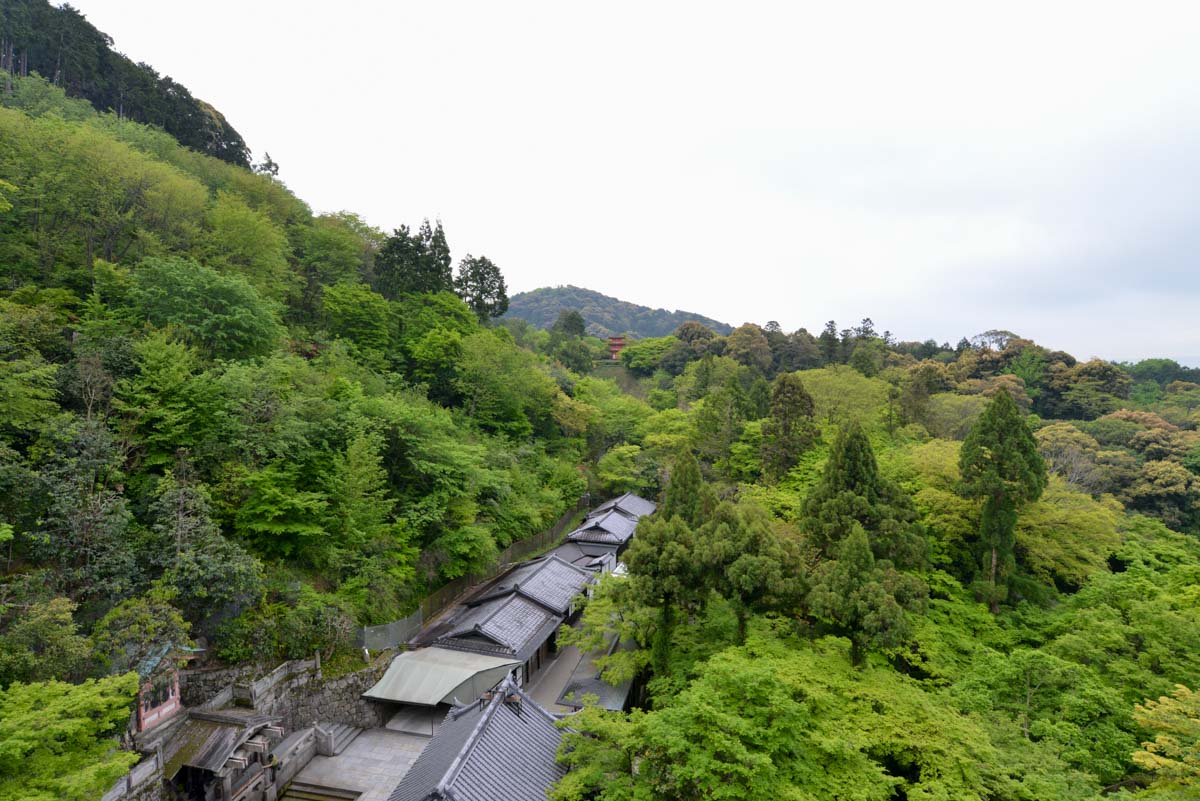
There is a shrine called Jishu Shrine in Kiyomizu Temple. It is a popular shrine that is visited by many people as a god of marriage.
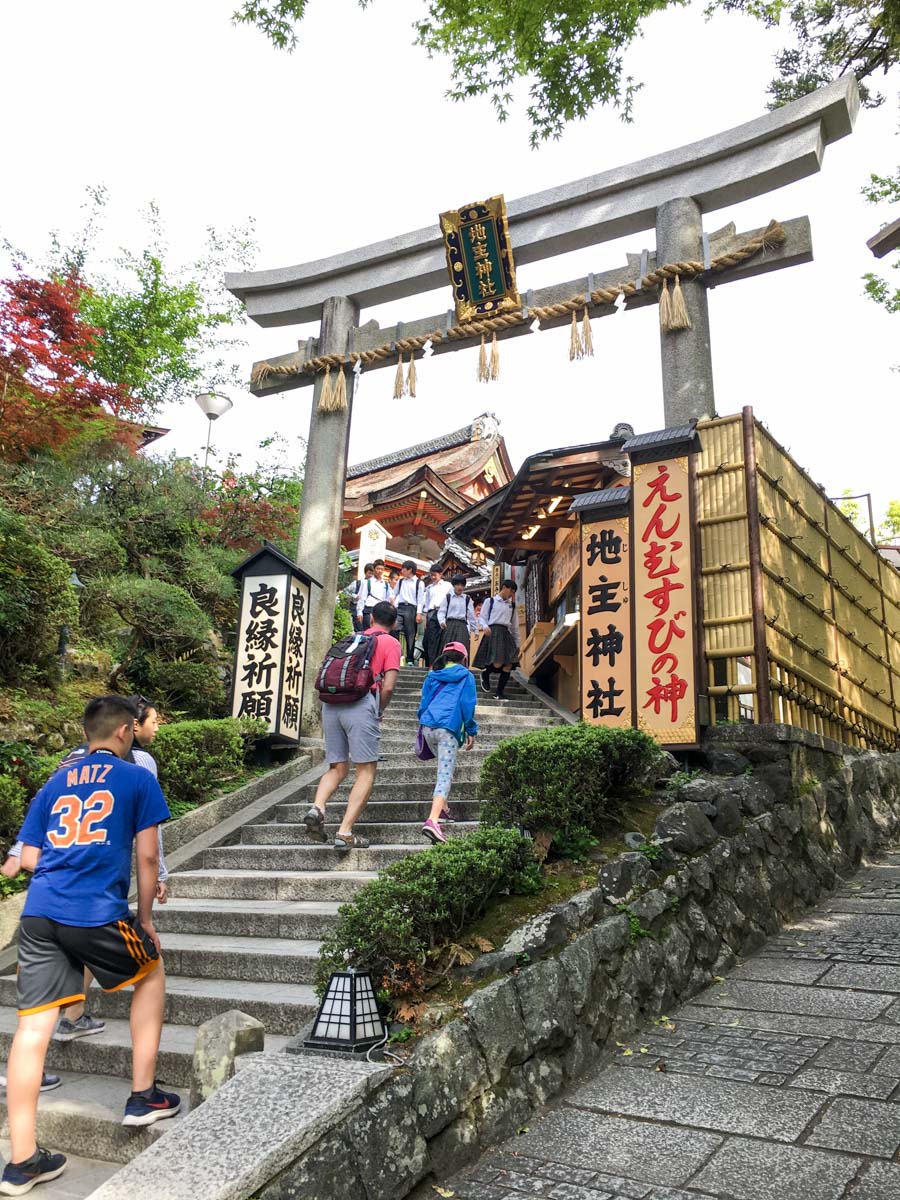
Now it’s time to take a look at the repaired main hall!
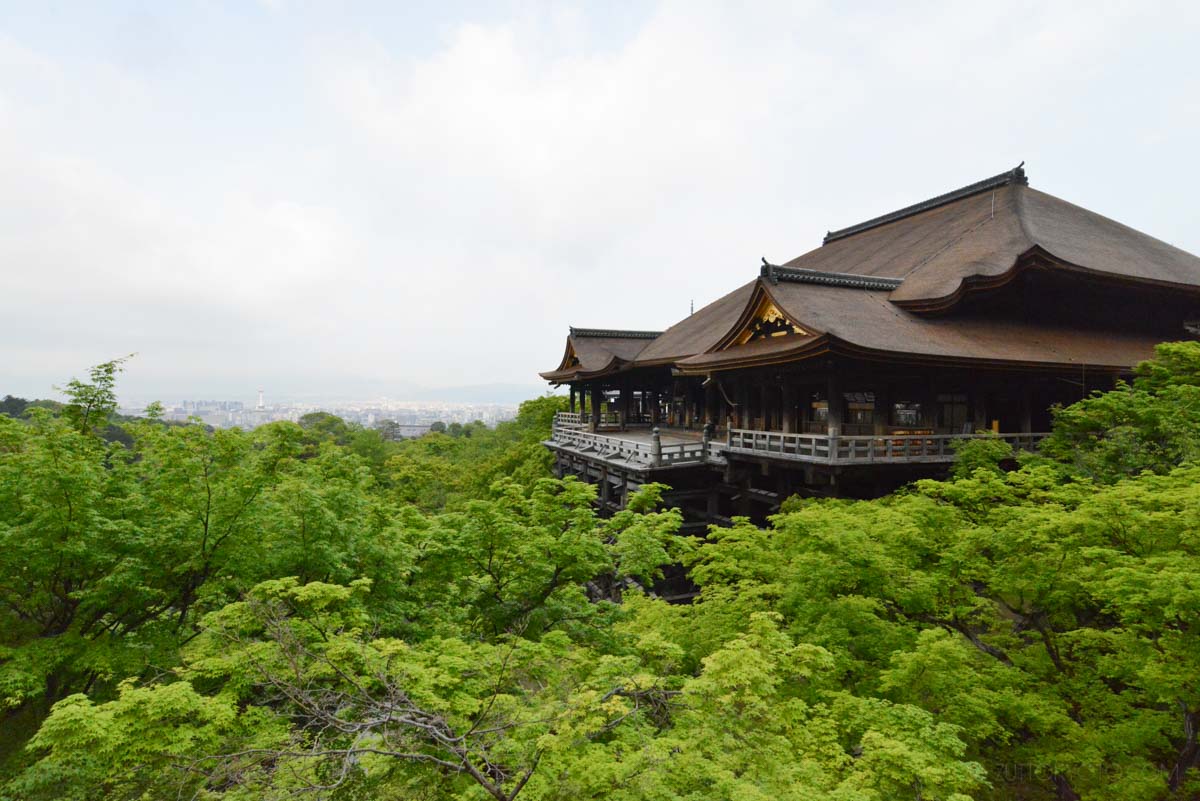
The massive main hall is full of dignity. It was beautiful against the fresh greenery!
We could see Kyoto Tower faintly in the distance. Walking down the path to the waterfall, you will find Otowa Falls.
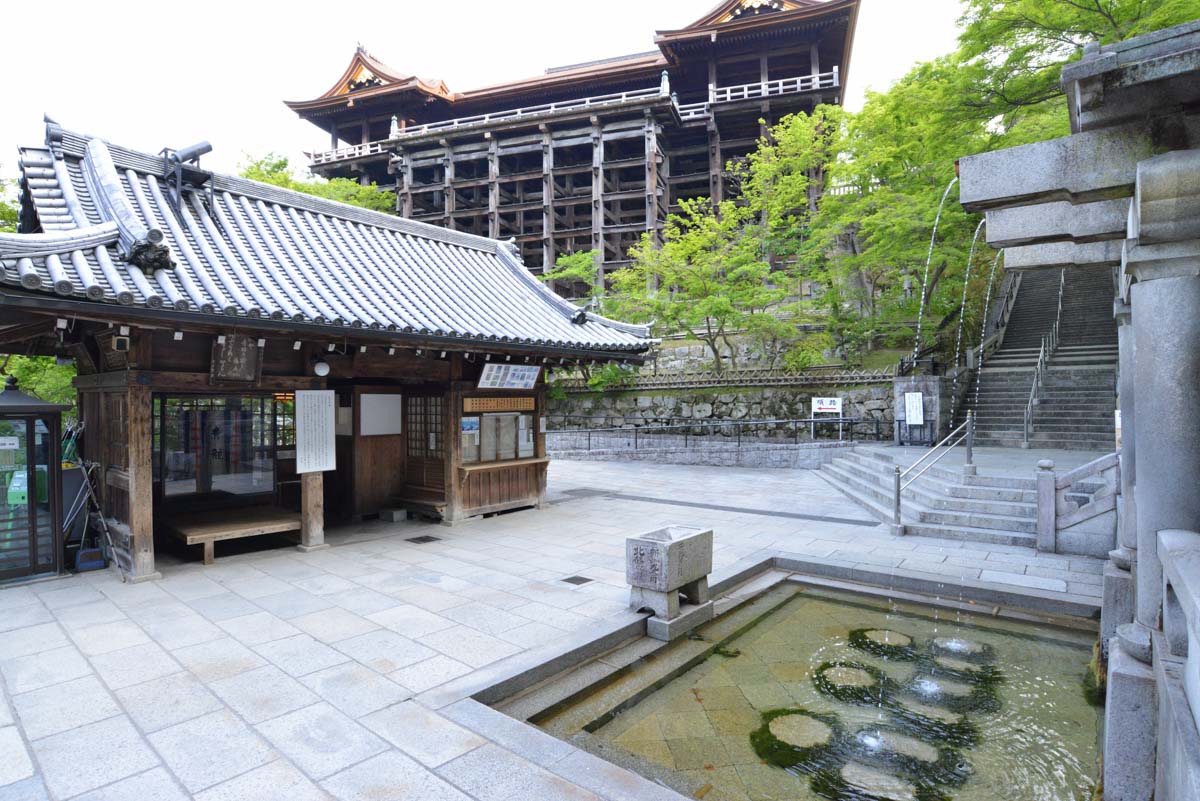
Otowa Waterfall is the origin of Kiyomizu Temple.
The waterfall is said to have been dyed red when a giant snake was exterminated at the source of the water,
Mount Ushio, and has been called “golden water” and “life-giving water” since ancient times.
It is a popular spot that many visitors usually visit.
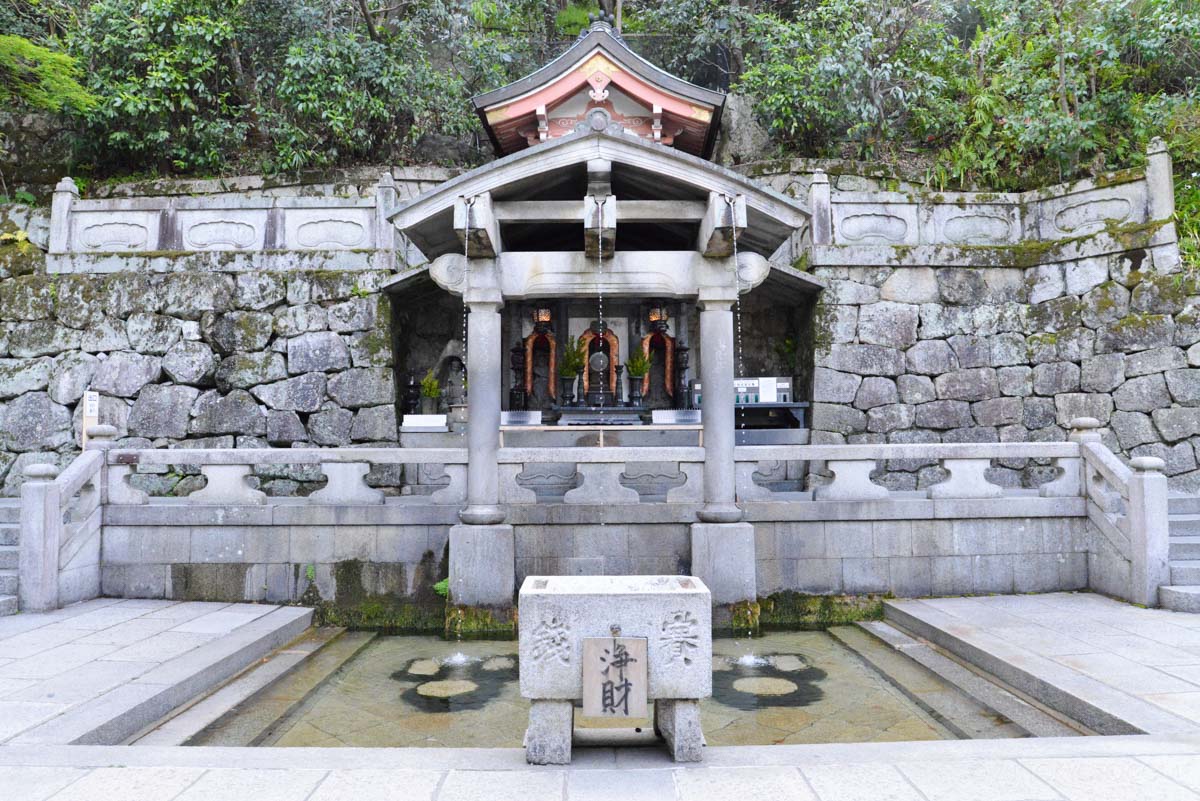
Early in the morning, monks from Kiyomizu-dera Temple were chanting sutras at this and other waterfalls.
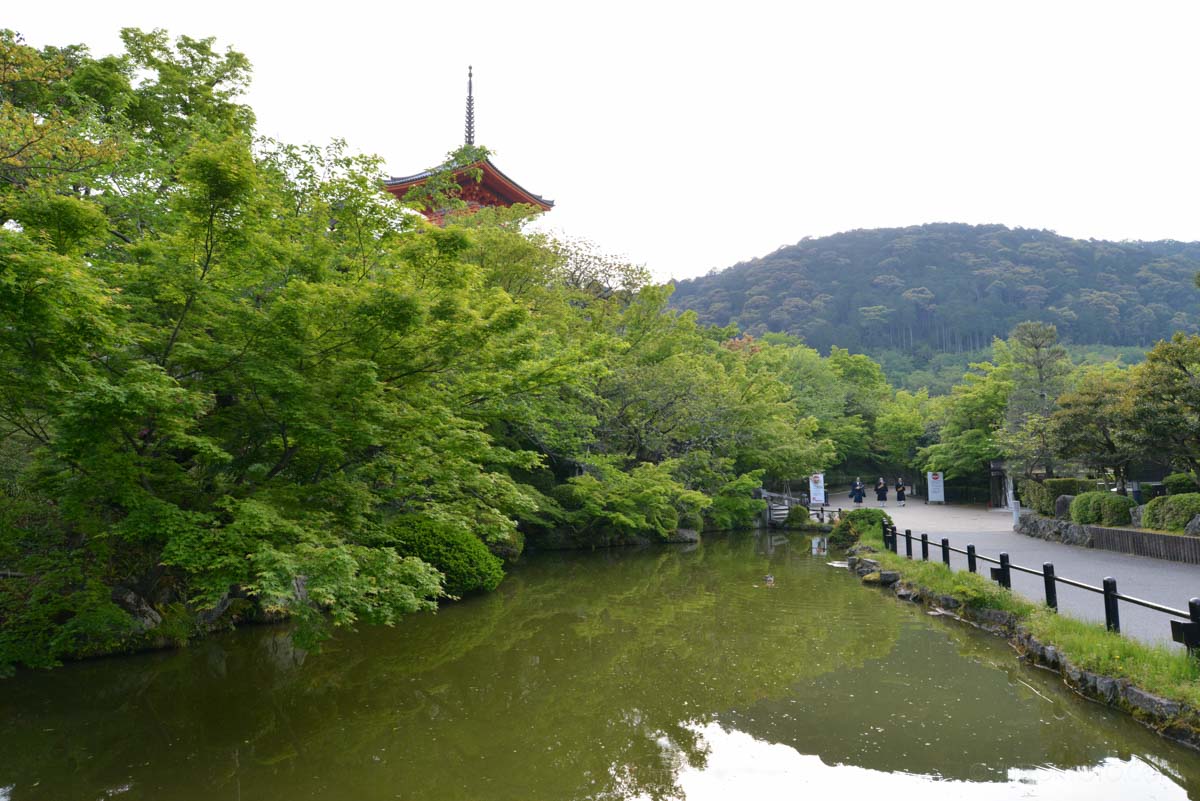
This time you visited Heian-jingu Shrine, Nanzen-ji Temple, Yasaka-jinja Shrine and Kiyomizu-dera Temple,
which are the standard sightseeing spots in Rakuto. How was it?
The scenery and atmosphere are different depending on the season, so you can enjoy it whenever you come.
After sightseeing at Kiyomizu Temple, it is good to look for souvenirs and eat around.
Chawanzaka is also nearby, so it is recommended for those who like tableware.
It’s fun just to see the real Kiyomizuyaki.
Please find your favorite spots when you come to Kyoto!
Then I will summarize the Rakuto course.
Q: When do you recommend going?
A: If you want to enjoy cherry blossoms and autumn leaves,
cherry blossoms will be around April and autumn leaves around 11.
For those who don’t like crowds, it is safe to use other seasons.
Recommended is around May, not too cold and not too hot. (* It is crowded during Golden Week.)
Q: Where is a good place to buy souvenirs?
A: After seeing the last Kiyomizu Temple, I recommend you to look around near Kiyomizu Temple.
